Clearing all math exams can be tough for students who are pursuing 5th grade but with Big Ideas Math Answers Grade 5 Chapter 3 Add and Subtract Decimals it can be easy. Because this solutions key is prepared by our highly-experienced subject experts after ample research and easy to understand the concepts too. So, students are implied to answer all the questions while practicing and cross-check the solutions through Big Ideas Math Answers Grade 5 Chapter 3 Add and Subtract Decimals.
Big Ideas Math Book 5th Grade Answer Key Chapter 3 Add and Subtract Decimals
You just need to tap on the quick links available in order to access them and learn all the topics. Bridge the Knowledge Gap taking the help of the Big Ideas Math Answers Grade 5 Chapter 3 Add and Subtract Decimals. Kick start your preparation using these resources and clear the exams with flying colors. Solutions provided in the Big Ideas Math Book 5th Grade Answer Key Chapter 3 Add and Subtract Decimals cover questions from all the Exercises, Cumulative Practice, etc.
Lesson: 1 Estimate Sum and Differences
Lesson: 2 Use Models to Add or Subtract Decimals
- Lesson 3.2 Use Models to Add or Subtract Decimals
- Use Models to Add or Subtract Decimals Homework & Practice 3.2
Lesson: 3 Add Decimals
Lesson: 4 Subtract Decimals
Lesson: 5 Add and Subtract Decimals
Lesson: 6 Use Mental Maths to Add or Subtract Decimals
- Lesson 3.6 Use Mental Maths to Add or Subtract Decimals
- Use Mental Maths to Add or Subtract Decimals Homework & Practice 3.6
Lesson: 7 Problem Solving: Money
Chapter: 3 – Add and Subtract Decimals
- Add and Subtract Decimals Performance Task
- Add and Subtract Decimals Activity
- Add and Subtract Decimals Chapter Practice
- Add and Subtract Decimals Cumulative Practice
- Add and Subtract Decimals STEAM Performance Task
Lesson 3.1 Estimate Sum and Differences
Explore and Grow
Estimate each sum or difference.

Answer:

Construct Arguments
Compare your answers to your partner’s answers. Explain why they are the same or why they are different.
Answer:
My Friend and My answers are the same in the process of addition and subtraction.
Think and Grow: Estimate Sums and Differences
You can use rounding or compatible numbers to estimate sums and differences of decimals.+
Example
Estimate 27.21 + 48.73.
One Way: Use rounding. Round each addend to the nearest whole number. Then find the sum of the rounded numbers.

So, 27.21 + 48.73 is about _____.
Answer:
So, 27.21 + 48.73 is about 76.
Explanation:
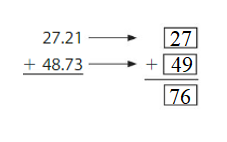
Another Way: Use compatible numbers.

So, 27.21 + 48.73 is about _______.
Answer:
So, 27.21 + 48.73 is about 80.
Explanation:

Example
Estimate 388.5 + 103.2.
One Way: Use rounding. Round each number to the nearest ten. Then find the difference of the rounded numbers.

So, 388.5 – 103.2 is about ______.
Answer:
So, 388.5 – 103.2 is about 492.
Explanation:
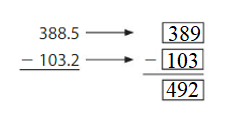
Another Way: Use compatible numbers.

So, 388.5 – 103.2 is about ______.
Answer:
So, 388.5 – 103.2 is about 505.
Explanation:

Show and Grow
Estimate the sum or difference.
Question 1.

Answer:

Sum of 112.18 + 47.99 = 160.17
Question 2.

Answer:

Difference of 68.8 – 29.7 = 39.1.
Apply and Grow: Practice
Estimate the sum or difference.
Question 3.

Answer:

Difference of 7.95 – 1.72 = 6.23.
Question 4.

Answer:

Sum of 237.5 + 345.1 = 582.6.
Question 5.
67.5 + 15.1
Answer:
Sum of 67.5 + 15.1 = 82.6

Question 6.
418.9 – 14.7
Answer:
Difference of 418.9 – 14.7 = 404.2.
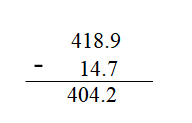
Question 7.
13.9 – 8.21
Answer:
Difference of 13.9 – 8.21 = 5.69.

Question 8.
208.6 + 56.9
Answer:
Sum of 208.6 + 56.9 = 265.5.

Question 9.
Number Sense
Descartes estimates a sum by rounding each number to the nearest ten. His estimate is 140. Which sums could he have estimated?
83.6 + 59.8
106.92 + 44.68
130.8 + 4.68
73.5 + 67.4
Answer:
Descartes estimates a sum of 73.5 + 67.4 = 140.9 to be 140 by rounding each number to the nearest ten.
Explanation:
First, we need to calculate the sum by rounding each number to the nearest ten:
83.6 + 59.8 = 143.4
106.92 + 44.68 = 151.6
130.8 + 4.68 = 135.48
73.5 + 67.4 = 140.9
Question 10.
Precision
Does rounding 209.11 – 104.53 to the nearest ten or to the nearest hundred give an estimate that is closer to the actual difference? Explain.
Answer:
Estimation to the difference by rounding to nearest ten ( 209 – 105 = 104 )is closer to the actual difference ( 209.11 – 104.53 = 104.58 ).
Explanation:
First, Estimate the actual difference:
209.11 – 104.53 = 104.58
Second, Estimate the difference by rounding to nearest ten:
209 – 105 = 104
Third, Estimate the difference by rounding to nearest hundred:
200 – 100 = 100
Question 11.
DIG DEEPER!
Newton packs a suitcase to fly on a plane. His suitcase needs to weigh less than 50.0 pounds. Should Newton overestimate or underestimate the weight of his suitcase? Explain.
Answer: Newton should overestimate the weight of his suitcase because the weigh should not be more than 50.0 pounds.
Think and Grow: Modeling Real Life
Example
About how many feet taller is One World Trade Center than the Empire State Building?

Round the height of each building to the nearest hundred because you do not need a precise answer.
One World Trade Center: 1,800 feet
Empire State Building: 1,500 feet
Subtract the estimated height of the Empire State Building from the estimated height of One World Trade Center.

One World Trade Center is about ______ feet taller than the Empire State Building.
Answer:
One World Trade Center is about 300 feet taller than the Empire State Building.
Explanation:
One World Trade Center: 1,800 feet
Empire State Building: 1,500 feet
Subtract the estimated height of the Empire State Building from the estimated height of One World Trade Center.
 –
–
Difference of 1800 – 1500 = 300 feet.
Show and Grow
Question 12.
About how many more tons does the African elephant weigh than the hippopotamus?

Answer:
Weight of African Elephant is 3.4 Tons more than the Weight of Hippopotamus.
Explanation:
Weight of African Elephant = 5.7 Tons
Weight of Hippopotamus = 2.3 Tons
Difference:
Weight of African Elephant – Weight of Hippopotamus = 5.7 – 2.3 = 3.4 Tons
Question 13.
One cup of wild rice has 6.5 grams of protein. One cup of shredded chicken has 36.9 more grams of protein than 1 cup of wild rice. About how many grams of protein are in 1 cup of chicken?
Answer:
1 cup of chicken = 43.4 grams of protein.
Explanation:
One cup of wild rice = 6.5 grams
One cup of shredded chicken has 36.9 more grams of protein than 1 cup of wild rice
=> 1 cup of chicken = 36.9 grams + 6.5 grams
=> 1 cup of chicken = 43.4 grams of protein.
Question 14.
The speed Earth orbits the Sun is 18.5 miles per second. This speed is 3.3 miles per second slower than the speed Venus orbits the Sun. About how fast does Venus orbit the Sun?
Answer:
Speed of Venus orbit the Sun is 15.2 miles fast than the Earth orbit per second.
Explanation:
Speed of Earth orbits the Sun = 18.5 miles
This speed is 3.3 miles per second slower than the speed Venus orbits the Sun
=> Speed of Venus orbit the Sun = 18.5 – 3.3 miles = 15.2 miles
Estimate Sum and Differences Homework & Practice 3.1
Estimate the sum or difference.
Question 1.

Answer:
Sum of 76.81 + 2.17 =78.98.

Question 2.

Answer:
Difference of 79.1 – 32.8 = 46.3

Question 3.
418.44 – 23.61
Answer:
Difference of 418.44 – 23.61 = 442.05

Question 4.
90.7 + 2.3
Answer:
Sum of 90.7 + 2.3 = 93

Question 5.
6.24 – 3.8
Answer:
Difference of 6.24 – 3.8 = 2.44
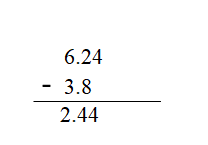
Question 6.
837.51 + 149.27
Answer:
Sum of 837.51 + 149.27 = 986.78

Question 7.
Open-Ended
Write a decimal addition problem that has an estimated sum of 35.
Answer:
Sum of 16.3+18.7 = 35
Explanation:
16.3+18.7 =??

Question 8.
Reasoning
Describe a situation when you would estimate the difference of 25.4 and 19.8 to the nearest whole number.
Answer:
Estimate the difference between 25.4 and 19.8 by to round each number to the nearest whole number and then subtract the rounded numbers.
Explanation:
Rounding number to nearest whole number of 25.4 = 25
Rounding number to nearest whole number of 19.8 = 20
Difference = Rounding number to nearest whole number of 25.4 – Rounding number to nearest whole number of 19.8
= 25 – 20
= 5
Question 9.
Modeling Real Life
Your friend participates in a 3.1-mile race. She walks for 1.4 miles of the race and runs the rest. About how many miles does your friend run?
Answer:
Number of miles my Friend runs = 1.7 miles.
Explanation:
Number of miles the race is my Friend participates = 3.1 mils
Number of miles my Friend walks = 1.4 miles
Number of miles my Friend runs = Number of miles the race is my Friend participates – Number of miles my Friend walks
=> 3.1 – 1.4
=> 1.7 miles.
Question 10.
DIG DEEPER!
Your phone has 16,000 megabytes of total storage space. About how much storage space is free?

Answer:
Free Storage space left in Phone = 2944.8 megabytes
Explanation:
Total storage space of Phone = 16000 megabytes
Memory Storage for Photos = 3111.1 megabytes
Memory Storage for Applications = 5345.3 megabytes
Memory Storage for Music = 4598.8 megabytes
Free Storage space = Total storage space of Phone – ( Memory Storage for Photos + Memory Storage for Applications +
Memory Storage for Music)
=> 16000 – ( 3111.1 + 5345.3 + 4598.8 )
=> 16000 – 13055.2
=> 2944.8 megabytes
Review & Refresh
Find the sum.
Question 11.
\(\frac{2}{8}+\frac{4}{8}\) = ______
Answer:
\(\frac{2}{8}+\frac{4}{8}\) = \(\frac{3}{4}\) .
Explanation:
\(\frac{2}{8}+\frac{4}{8}\) = \(\frac{2+4}{8}\) = \(\frac{6}{8}\) = \(\frac{3}{4}\)
Question 12.
\(\frac{1}{2}+\frac{5}{2}\) = ______
Answer:
\(\frac{1}{2}+\frac{5}{2}\) = \({3}\) .
Explanation:
\(\frac{1}{2}+\frac{5}{2}\) = \(\frac{1+5}{2}\) = \(\frac{6}{2}\) = \({3}\)
Question 13.
1 + \(\frac{1}{4}\) = ______
Answer:
1 + \(\frac{1}{4}\) = \(\frac{5}{4}\) .
Explanation:
1 + \(\frac{1}{4}\) = \(\frac{4+1}{4}\) = \(\frac{5}{4}\)
Lesson 3.2 Use Models to Add or Subtract Decimals
Explore and Grow
Use base ten blocks to find 1.4 + 0.7.

Use base ten blocks to find 1.16 – 0.89.
Answer:
So, 1.16 – 0.89 = 0.27
Explanation:
1.16 – 0.89 =  –
–  =
= 
Repeated Reasoning
Why can you use base ten blocks to model ones, tenths, and hundredths?
Answer:
Yes, we can use base ten blocks to model ones, tenths, and hundredths because they represent the numeral values in blocks which helps is east calculation and understanding.
Think and Grow: Use Models to Add or Subtract Decimals
You have used models to add or subtract whole numbers. You can use similar models to add or subtract decimals.
Example
Find 1.5 + 2.7.
Make a quick sketch. Add the tenths, then the ones.
Regroup 10 tenths as 1 one.

So, 1.5 + 2.7 = _____.
Answer:
So, 1.5 + 2.7 = 3.2
Explanation:

Example
Find 2.42 – 1.24.
So, 2.42 – 1.24 = _____.
Answer:
So, 2.42 – 1.24 = 1.18
Explanation:
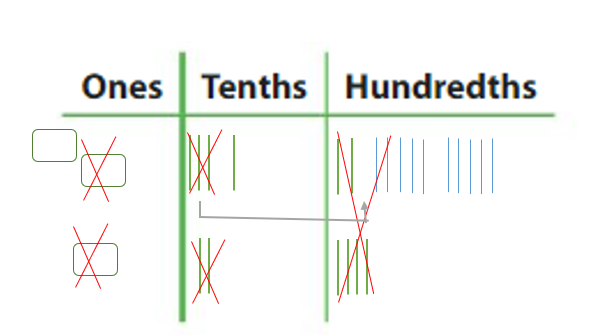
Show and Grow
Make a quick sketch to find the sum or difference.
Question 1.
3.15 + 0.92 = _____

Answer:
3.15 + 0.92 = 4.07
Explanation:
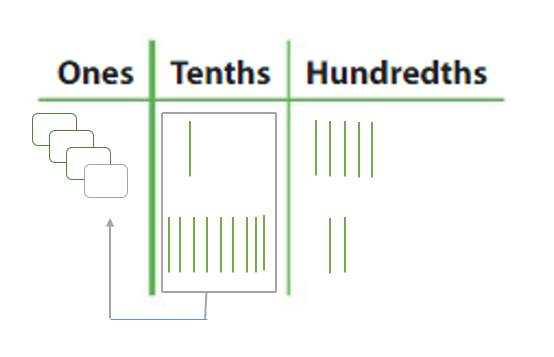
Question 2.
1.26 – 0.83 = _____

Answer:
1.26 – 0.83 = 0.43
Explanation:

Apply and Grow: Practice
Make a quick sketch to find the sum or difference.
Question 3.
1.61 + 0.22 = _____
Answer:
1.61 + 0.22 = 1.83
Explanation:

Question 4.
2.4 – 1.3 = _____
Answer:
2.4 – 1.3 = 1.1
Explanation:

Question 5.
2.2 + 0.9 = _______
Answer:
2.2 + 0.9 = 3.1
Explanation:

Question 6.
1.56 – 1.08 = ______
Answer:
1.56 – 1.08 = 0.48
Explanation:

Question 7.
Number Sense
Newton adds two decimals that are each greater than 0.5. What can you conclude about the sum?
Answer:
If Newton’s adds two decimals that are each greater than 0.5 then the Sum of the decimal numbers is going to be more than 0.5.
Explanation:
First Decimal Number= 1.2
Second Decimal Number = 0.8
Sum = First Decimal Number + Second Decimal Number
= 1.2 + 0.8 = 2.0
Question 8.
Structure
Write an equation represented by the quick sketch.

Answer:
The Equation for the given quick Sketch :
3.54 + 1.63 = 5.17
Question 9.
DIG DEEPER!
Use a model to find 1.31 – 0.4.
Answer:
1.31 – 0.4 = 0.91.54
Explanation:
1.31 – 0.4 = ???

Think and Grow: Modeling Real Life
Example
How much longer is the duration of the wooden roller-coaster ride than the duration of the steel roller-coaster ride?
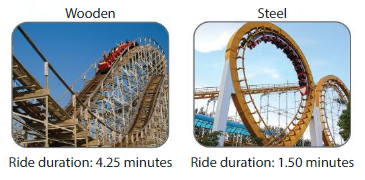
Find the difference of the durations: 4.25 – 1.50.
Make a quick sketch of 4.25.

So, 4.25 – 1.50
Answer:
So, 4.25 – 1.50 = 2.75.
Explanation:

So, 4.25 – 1.50 = ???
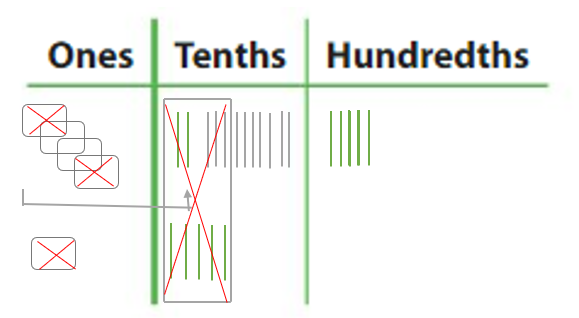
Show and Grow
Question 10.
A football player completes a 40-yard dash in 5.84 seconds. Another player completes it in 4.56 seconds. How much longer does it take the first player to complete the 40-yard dash than the second player?
Answer:
Time taken by the the first player to complete the 40-yard dash 1.28 seconds more than the second player.
Explanation:
Time taken by the First player to complete the 40-yard dash = 5.84 seconds
Time taken by the Second player to complete the 40-yard dash = 4.56 seconds
Time taken by the the first player to complete the 40-yard dash than the second player = Time taken by the First player to complete the 40-yard dash – Time taken by the Second player to complete the 40-yard dash
= 5.84 seconds – 4.56 seconds
= 1.28 seconds.
Question 11.
What is the total length of the narwhal?

Answer:
Total Length of whole body Narwhal = 16.40 feet.
Explanation:
Length of Narwhal tusk = 4.92 feet
Length of Narwhal Body = 11.48 feet
Total Length of whole body Narwhal = Length of Narwhal tusk + Length of Narwhal Body
= 4.92 feet + 11.48 feet
= 16.40 feet.
Question 12.
DIG DEEPER!
An Olympic gymnast scores 6.6 points for skill. She starts with 10.0 points for execution, then loses 0.4 point for execution errors. What is the gymnast’s final score?
Answer:
Final score points of Olympic gymnast = 16.2.
Explanation:
Score points of Olympic gymnast for skill = 6.6
Score points of Olympic gymnast for execution = 10.0
Score points lost of Olympic gymnast for execution errors = 0.4
Final score points of Olympic gymnast = Score points of Olympic gymnast for skill + Score points of Olympic gymnast for execution – Score points lost of Olympic gymnast for execution errors
= 6.6 + 10.0 – 0.4
= 16.6 – 0.4
= 16.2
Use Models to Add or Subtract Decimals Homework & Practice 3.2
Make a quick sketch to find the sum or difference.
Question 1.
2.6 + 1.3 = ______

Answer:
2.6 + 1.3 = 3.9.
Explanation:
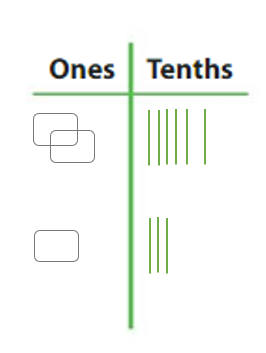
Question 2.
1.36 – 0.25 = _____

Answer:
1.36 – 0.25 = 1.11
Explanation:

Question 3.
0.84 – 0.17 = _____
Answer:
0.84 – 0.17 = 0.67.
Explanation:

Question 4.
1.25 + 1.55 = _____
Answer:
1.25 + 1.55 = 2.80.
Explanation:

Question 5.
2.6 – 1.9 = ______
Answer:
2.6 – 1.9 = 0.7.
Explanation:
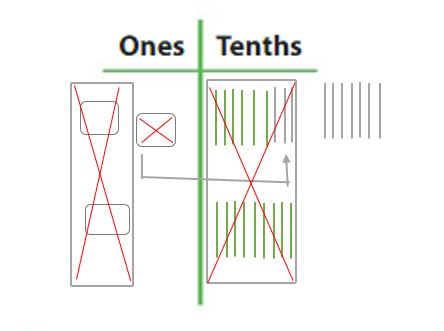
Question 6.
3.9 + 0.6 = ______
Answer:
3.9 + 0.6 = 4.5.
Explanation:

Question 7.
Structure
Write an equation represented by the quick sketch.
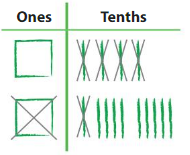
Answer:
Question 8.
Number Sense
What is the greatest possible difference of two decimals to the hundredths place that are between 0 and 1?
Answer:
0.01 is the greatest possible difference of two decimals to the hundredths place that are between 0 and 1.
Question 9.
DIG DEEPER!
Write a decimal addition equation that requires regrouping the tenths. Explain how you know you need to regroup to add.
Answer:
Find the Sum of 1.5 +2.7 = 4.2
Explanation:

Question 10.
Modeling Real Life
The fastest 1-mile sack race was completed in 16.68 minutes. The fastest 1-mile piggyback race was completed in 11.18 minutes. How much longer did it take to complete the sack race than the piggyback race?
Answer:
Time taken to complete the sack race than the piggyback race = 5.5 minutes.
Explanation:
Time taken to complete fastest 1-mile sack race = 16.68 minutes
Time taken to complete fastest 1-mile piggyback race = 11.18 minutes
Time taken to complete the sack race than the piggyback race = Time taken to complete fastest 1-mile sack race – Time taken to complete fastest 1-mile piggyback race
= 16.68 – 11.18
= 5.5 minutes
Question 11
Modeling Real Life
How many pounds of honey do the hives produce in all?

Answer:
Total number of pounds of Honey produced by Hive A and Hive B = 36.23 lb.
Explanation:
Number of pounds of Honey Hive A produce = 15.25 lb.
Number of pounds of Honey Hive B produce = 20.98 lb.
Total number of pounds of Honey produced Hive A and Hive B = Number of pounds of Honey Hive A produce + Number of pounds of Honey Hive B produce
= 15.25 + 20.98
= 36.23 lb.
Review & Refresh
Find the perimeter of the rectangle.
Question 12.

Answer:
Perimeter of Rectangle = 102 yards.
Explanation:
Length of Rectangle = 32 yards.
Width of Rectangle = 19 yards
Perimeter of Rectangle = 2 (l + w)
= 2( 32 + 19 )
= 2 × 51
= 102 yards.
Question 13.

Answer:
Perimeter of Rectangle = 114 mm.
Explanation:
Length of Rectangle = 36 mm
Width of Rectangle = 21 mm
Perimeter of Rectangle = 2 (l + w)
= 2 ( 36 + 21 )
= 2 × 57
= 114 mm.
Lesson 3.3 Add Decimals
Explore and Grow
Find the sum.


Use a model to find the sum. Draw your model.

Answer:


Explanation:

Construct Arguments
+-?
Answer:
The adding of decimals is same as to that of adding of whole numbers because here the process we do is adding the numbers in both.
Think and Grow: Add Decimals
To add decimals, add like place values.
Example
Add: 52.76 + 38.18. Estimate ______

Answer:
Sum of 52.76 +38.18 = 90.94
90.94 is close to 91.
Show and Grow
Find the sum. Check whether your answer is reasonable.
Question 1.

Answer:

5.6 is close to 6.
Explanation:

Question 2.

Answer:

1.76 is close to 2.
Explanation:
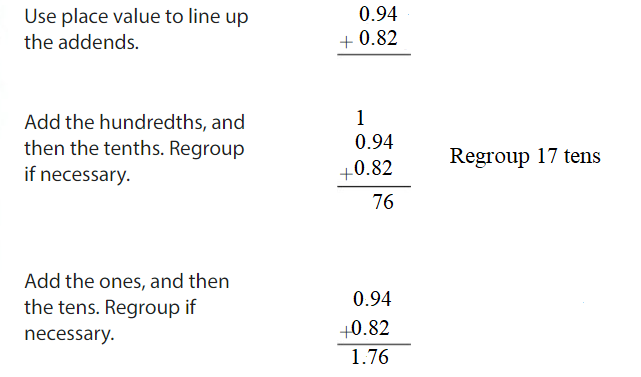
Question 3.

Answer:

93.7 is close to 94.
Explanation:

Question 4.

Answer:
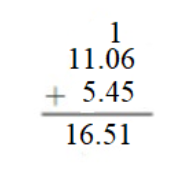
16.51 is close to 17.
Explanation:

Apply and Grow: Practice
Find the sum. Check whether your answer is reasonable.
Question 5.

Answer:

8.89 is close to 9.
Explanation:

Check:
8.89 – 1.07
= 7.82.
Question 6.

Answer:

38.7 is close to 39.
Explanation:

Check:
38.7 – 15.1
= 23.6.
Question 7.

Answer:

640.89 is close to 641.
Explanation:

Check:
640.89 – 78.04
= 562.65.
Question 8.
2.5 + 4.6 = _____
Answer:

7.1 is close to 7.
Explanation:

Check:
7.1 – 4.6
= 2.5.
Question 9.
107.5 + 63.5 = _____
Answer:

171.0 is close to 171.
Explanation:

Check:
171.0 – 63.5
= 107.5.
Question 10.
49.87 + 32.53 = ______
Answer:

82.40 is close to 82.
Explanation:

Check:
82.40 – 32.53
= 49.87.
Question 11.
96.5 + 4.1 = _____
Answer:
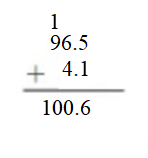
100.6 is close to 101.
Explanation:

Check:
100.6 – 4.1
= 96.5.
Question 12.
Number Sense
Which expressions have a sum greater than 24.7?
20.9 + 3.8
15.96 + 9.51
14.23 + 9.85
10.62 + 14.11
Answer:
The Sum of 15.96 + 9.51= 25.74 which is greater than 24.7.
Explanation:
First, find the sum:
20.9 + 3.8 = 24.7
15.96 + 9.51 = 25.47
14.23 + 9.85 = 24.08
10.62 + 14.11 = 24.73
Question 13.
YOU BE THE TEACHER
Your friend finds 34.5 + 6.8 and gets a sum of 413. Without adding, explain how you know your friend’s answer is correct.
Answer:
My Friend’s answer is incorrect because he did not add the digits correctly .
Explanation:
Find the Sum :
34.5 + 6.8 = 41.3

Think and Grow: Modeling Real Life
Example
You have 6.5 megabytes of storage space left on your tablet. Do you have enough space to download both of the ebooks?
Add the ebook file sizes.

Compare the sum of the file sizes to the available space on your tablet.
You ______ have enough room to download both ebooks.
Answer:
I have enough space to download both ebooks.
Explanation:
Storage space for tale of the Monster = 3.8 megabytes
Storage space for In the Game = 2.5 megabytes
Total storage for tale of the Monster and In the Game = 3.8 + 2.5 = 6.3 megabytes
Storage space left on the Tablet = 6.5 megabytes
Storage space left after downloading the eBooks = Storage space left on the Tablet – Total storage for tale of the Monster and In the Game
= 6.5 – 6.3
= 0.2 megabytes
Show and Grow
Question 14.
A chef needs 3.75 pounds of fish for a dinner party. She catches a fish that is 2.50 pounds and another fish that is 1.75 pounds. Does she catch enough fish for her dinner party?
Answer:
She catches enough fish for her dinner party in fact 0.5 pounds more weight fish she catches.
Explanation:
Weight of first fish = 2.50 pounds
Weight of Second Fish = 1.75 pounds
Weight of both Fishes = 2.50 + 1.75 = 4.25 pounds
Weight of the fish needed for a dinner party = 3.75 pounds
Difference:
Weight of fishes caught – Weight of the fish needed for a dinner party
= 4.25 – 3.75
= 0.5 pounds
Question 15.
Your school’s long jump record is 5.51 meters. You jump 3.38 meters on your first attempt. Your second attempt is 1.56 meters longer than your first. Do you break your school’s record?
Answer:
I have broke the school record by jumping more 2.81 meters than the record distance.
Explanation:
Distance long jump record in the school = 5.51 meters
Distance jumped on my first attempt = 3.38 meters
Your second attempt is 1.56 meters longer than your first.
=> Distance jumped on my second attempt = 1.56+ 3.38 meters = 4.94 meters
Total distance jumped by me = Distance jumped on my first attempt + Distance jumped on my second attempt
= 3.38 + 4.94
= 8.32 meters
Difference:
Total distance jumped by me – Distance long jump record in the school
= 8.32 – 5.51
= 2.81 meters
Question 16.
The melting point of aluminum is 403.86 degrees Celsius cooler than the melting point of gold. What is the melting point of gold?

Answer:
The melting point of Gold = 1063.32 degrees Celsius.
Explanation:
The melting point of aluminum = 660.32 degrees Celsius
The melting point of aluminum is 403.86 degrees Celsius cooler than the melting point of gold.
=> Let the melting point of Gold be X
=> X- 403.86 = 660.32
=> X = 660.32 + 403
=> X = 1063.32 degrees Celsius.
Add Decimals Homework & Practice 3.3
Find the sum. Check whether your answer is reasonable.
Question 1.

Answer:

8.8 is close to 9.
Explanation:

Check:
8.8 – 1.3 = 7.5.
Question 2.

Answer:

683.89 is close to 684.
Explanation:

Check:
683.89 – 82.31 = 601.58.
Question 3.
19.73 + 7.16 = _____
Answer:

26.89 is close to 27.
Explanation:

Check:
26.89 – 7.16 = 19.73.
Question 4.
84.6 + 44.7 = ______
Answer:

129.3 is close to 129.
Explanation:

Check:
129.3 – 44.7 = 84.6.
Find the sum. Check whether your answer is reasonable.
Question 5.
123.98 + 47.65 = _____
Answer:
123.98 + 47.65 = 171.63.
171.63 is close to 172.
Explanation:

Check:
171.63 – 47.65
= 123.98.
Question 6.
427.8 + 13.2 = _____
Answer:
427.8 + 13.2 = 441.0
441 is close to 441.
Explanation:

Check:
441.0 – 13.2 = 427.8.
Question 7.
Reasoning
Your friend adds 46.7 and 5.4. Without calculating, is the sum greater than or less than 51? Explain.
Answer:
Answer is greater than 51 because the Sum of 46.7 + 5.4 = 52.1.
Explanation:
First Find the Sum:
46.7 + 5.4 = 52.1.

Question 8.
Writing
Explain why it is important to use place value to line up the numbers when adding decimals.
Answer:
When we add whole numbers, in the Value (cents) column above, you line up the numbers so that the digits in the ones place-value column are aligned. In order to keep the numbers in the proper place-value column when adding decimals, align the decimal points.
Question 9.
Modeling Real Life
You need 10.5 pounds of fruit for a fruit salad. You buy 3.8 pounds of apples and 6.7 pounds of pears. Do you buy enough fruit?

Answer:
Yes, there are enough fruits for a fruit salad.
Explanation:
Weight of fruits for a fruit salad needed = 10.5 pounds
Weight of Apples purchased = 3.8 pounds
Weight of pears purchased = 6.7 pounds
Total Weight of apples And Pears purchased = Weight of Apples purchased + Weight of pears purchased
= 3.8 + 6.7
= 10.5 pounds
=> Compare:
Weight of fruits for a fruit salad needed : Total Weight of apples And Pears purchased
= 10.5 pounds :10.5 pounds
Question 10.
Modeling Real Life
A scientist has 200.59 grams of mercury. She has 135.23 fewer grams of zinc. How many grams of zinc does she have?
Answer:
Zinc she has is 65.36 grams.
Explanation:
Mercury a Scientist has = 200.59 grams
She has 135.23 fewer grams of zinc
=> Let the Zinc be X
=> X + 135.23 = 200.59
=> X = 200.59 – 135.23
=> X = 65.36 grams.
Review & Refresh
Find the factor pairs for the number.
Question 11.
24
Answer:
Factor pairs of 24 :
1 × 24
2 × 12
3 × 8
4 × 6
Question 12.
36
Answer:
Factor pairs of 36 :
1 × 36
2 × 18
3 × 12
4 × 9
6 × 6
Question 13.
17
Answer:
Factor pairs of 17 :
1 × 17
17 is a prime number so it has 1 and itself as factors.
Lesson 3.4 Subtract Decimals
Explore and Grow
Find the difference.


Use a model to find the difference. Draw your model.

Answer:


Explanation:

Construct Arguments
How is subtracting decimals similar to subtracting whole numbers?
Answer:
Subtracting decimals is similar to subtracting whole numbers because the process is same for both kind of numbers that is subtracting.
Think and Grow: Subtract Decimals
To subtract decimals, subtract like place values.
Example
Subtract: 18.93 – 7.66.
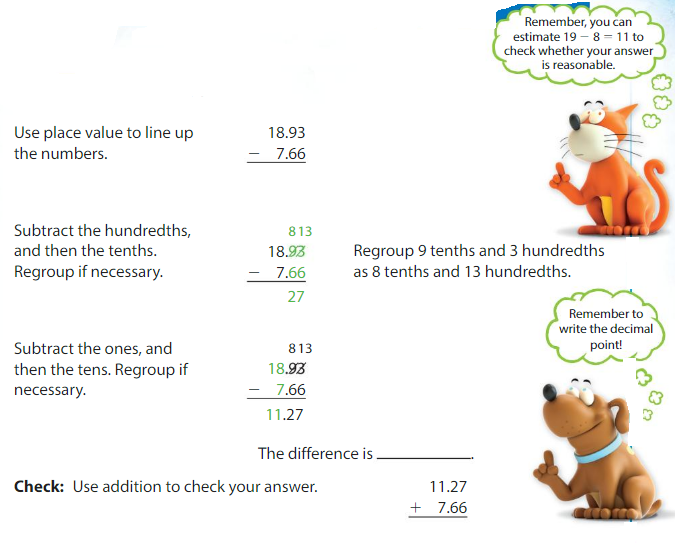
Show and Grow
Find the difference. Then check your answer.
Question 1.

Answer:

Explanation:
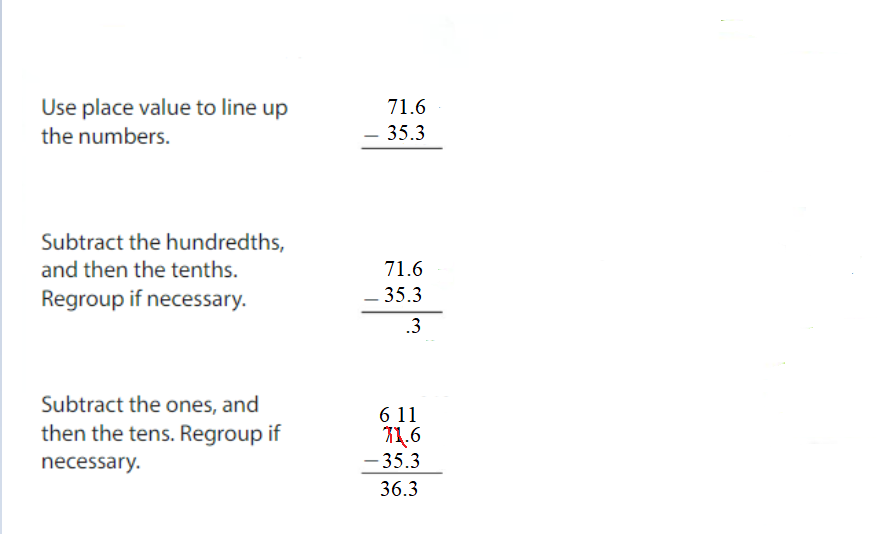
Check:
36.3 + 35.3 = 71.6
Question 2.

Answer:
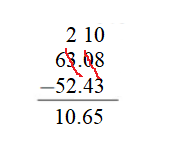
Explanation:

Check:
52.43 + 10.65 = 63.08.
Question 3.

Answer:
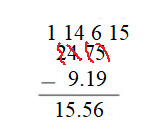
Explanation:

Check:
15.56 + 9.19 = 24.75.
Apply and Grow: Practice
Find the difference. Then check your answer.
Question 4.

Answer:

Explanation:

Check:
5.7 + 1.8 = 7.5.
Question 5.

Answer:

Explanation:

Check:
2.81 + 81.11 = 83.92.
Question 6.

Answer:

Explanation:

Check:
8.9 + 5.7 = 14.6.
Question 7.
856.02 – 48.12 = _______
Answer:
856.02 – 48.12 = 807.90.
Explanation:

Check:
48.12 + 807.90 = 856.02.
Question 8.
3.76 – 0.53 = _____
Answer:
3.76 – 0.53 = 3.23.
Explanation:

Check:
0.53 + 3.23 = 3.76.
Question 9.
27.5 – 21.7 = ______
Answer:
27.5 – 21.7 = 5.8.
Explanation:

Check:
21.7 + 5.8 = 27.5.
Question 10.
737.2 – 2.8 = _____
Answer:
737.2 – 2.8 = 734.4.
Explanation:

Check:
2.8 + 734.4 = 737.2.
Question 11.
YOU BE THE TEACHER
Your friend finds 534.8 – 23.9. Is your friend correct? Explain.

Answer:
My Friend’s answer is incorrect because he misplaced the digits and then did their difference.
Explanation:
First find the Difference:

Question 12.
DIG DEEPER!
Find y.
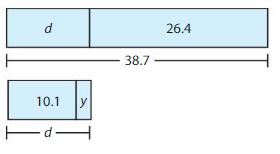
Answer:
y = 2.2
Explanation:
d + 26.4 = 38.7
=> d = 38.7 – 26.4
=> d = 12.3
d = y + 10.1
Substitute d = 12.3 in d = y + 10.1
=> d = y + 10.1
=> 12.3 = y + 10.1
=> y = 12.3 – 10.1
=> y = 2.2
Think and Grow: Modeling Real Life
Example
The world record for the longest dog tongue is 18.58 centimeters. The previous record was 11.43 centimeters. By how many centimeters was the record broken?

Subtract the previous record,11.43 centimeters, from the current record,18.58 centimeters.

So, the record was broken by ________ centimeters.
Answer:
Length of the record was broken by 7.15 centimeters.

Explanation:
Length of world record for the longest dog tongue = 18.58 centimeters
Length of previous world record for the longest dog tongue = 11.43 centimeters
Length of the record was broken = Length of world record for the longest dog tongue – Length of previous world record for the longest dog tongue
= 18.58 centimeters – 11.43 centimeters
= 7.15 centimeters.
Show and Grow
Question 13.
The average high summer temperature in Death Valley, California, is 46.7 degrees Celsius. The hottest temperature ever recorded is 56.7 degrees Celsius. How much greater is the hottest recorded temperature than the average high temperature?
Answer:
The hottest recorded temperature is greater by 10 degrees Celsius than the average high temperature.
Explanation:
The average high summer temperature in Death Valley, California = 46.7 degrees Celsius
The hottest temperature ever recorded = 56.7 degrees Celsius.
Difference:
=The hottest temperature ever recorded – The average high summer temperature in Death Valley, California
= 56.7 – 46.7
= 10 degrees Celsius
Question 14.
An athlete’s fitness tracker reads 2.69 miles at noon. The figure shows the athlete’s fitness tracker before going to sleep that night. How many miles were recorded after noon?

Answer:
Reading of an athlete’s fitness tracker recorded after noon = 3.65 miles.
Explanation:
Reading of an athlete’s fitness tracker at noon = 2.69 miles
Reading of an athlete’s fitness tracker before going to sleep=6.34 miles
Reading of an athlete’s fitness tracker recorded after noon = Reading of an athlete’s fitness tracker before going to sleep – Reading of an athlete’s fitness tracker at noon
= 6.34 – 2.69
= 3.65 miles.
Question 15.
DIG DEEPER!
Your friend is using a pattern to knit a 139.7-centimeter-long scarf. He has already knitted 61.8 centimeters. How many centimeters of scarf does he have left to knit? Write your answer as a mixed number.
Answer:
Length of scarf left to knit = 77.9/100 centimeters
Explanation:
Length of long scarf pattern to knit = 139.7 centimeter
Length of scarf already knitted = 61.8 centimeters
Length of scarf left to knit = Length of long scarf pattern to knit – Length of scarf already knitted
= 139.7 centimeter – 61.8 centimeters
= 77.9 centimeters
Subtract Decimals Homework & Practice 3.4
Find the difference. Then check your answer.
Question 1.

Answer:

Check:
21.5 + 13.0
= 34.5.
Question 2.

Answer:
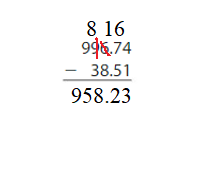
Check:
38.51 + 958.23
= 996.74.
Question 3.

Answer:

Check:
3.8 + 19.7
= 23.5.
Find the difference. Then check your answer.
Question 4.
856.02 – 48.12 = ______
Answer:
856.02 – 48.12
= 807.90
Check:
48.12 + 807.90
= 856.02
Question 5.
3.76 – 0.53 = ______
Answer:
3.76 – 0.53
= 3.23
Check:
0.53 + 3.23
= 3.76.
Question 6.
27.5 – 21.7 = ______
Answer:
27.5 – 21.7
= 5.8
Check:
21.7 + 5.8
= 27.5.
Question 7.
737.2 – 2.8 = _______
Answer:
737.2 – 2.8
= 734.4.
Check:
2.8 + 734.4
= 737.2.
Question 8.
Number Sense
Which statements describe the difference of 134.6 and 78.9?
The difference is 55.7.
The difference is greater than 55.
The difference is less than 55.07.
Answer:
The difference is 55.7 is the correct statement.
Explanation:
First find the Difference:

The difference is 55.7.
The difference is greater than 55.
The difference is less than 55.07.
Question 9.
DIG DEEPER!
Find the missing digits.

Answer:

Explanation:
Missing digit in tenths place:
Add tenths place 3 + 8 =11, => 1
Subtract the tenths digits and ones digits to get the missing digit in tens place.

Question 10.
Modeling Real Life
The world record for the longest fingernails on a pair of female hands is 576.41 centimeters. The world record for the longest fingernails on a single hand is 909.60 centimeters. How much longer is the world record for the longest fingernails on a single hand than the world record for the longest fingernails on a pair of female hands?
Answer:
The world record for the longest fingernails on a single hand is 333.19 centimeters longer than the world record for the longest fingernails on a pair of female hands.
Explanation:
Length of the world record for the longest fingernails on a pair of female hands = 576.41 centimeters.
Length of the world record for the longest fingernails on a single hand = 909.60 centimeters.
Difference:
Length of the world record for the longest fingernails on a single hand – Length of the world record for the longest fingernails on a pair of female hands
= 909.60 – 576.41
= 333.19 centimeters.
Review & Refresh
Find the product.
Question 11.
80 × 10 = ______
Answer:
Multiplication:
80 × 10 = 800.
Question 12.
30 × 90 = _______
Answer:
Multiplication:
30 × 90 = 2700.
Question 13.
60 × 70 = _______
Answer:
Multiplication:
60 × 70 = 4200.
Lesson 3.5 Add and Subtract Decimals
Explore and Grow
Add the decimals.

Answer:
1.36 + 2.5 + 2.78
= 3.86 + 2.78
= 6.64.
Explanation:
Count the given values:
1.36 + 2.5 + 2.78 = ???
Add the decimal values:

Reasoning
How did you find the sum? What other ways can you find the sum?
Answer:
First count the figures given place values and later add the decimals values.
Other ways are like counting total figures n doing the addition of them.
Think and Grow: Add and Subtract Decimals
Example
Add: 7.39 + 4.16 + 9. Estimate ________
Use place value to line up the addends. Add the hundredths, then the tenths, and then the ones.

Answer:
7.39 + 4.16 + 9.00 = 20.55.
20.55 is close to 21.
Explanation:

Example
Find 18.46 + 13.31 – 5.6. Estimate _______
Use order of operations.

Answer:
26.17 is close to 26.
Explanation:

Show and Grow
Evaluate. Check whether your answer is reasonable.
Question 1.
6.84 + 2.9 + 5.22 = ______
Answer:
6.84 + 2.9 + 5.22 = 14.96
14.96 is close to 15.
Explanation:

Check:
14.96 – 5.22 – 2.9
= 9.74 – 2.9
=6.84.
Question 2.
41.55 – 14.09 + 42.4 = ______
Answer:
41.55 – 14.09 + 42.4 = 69.86.
69.86 is close to 70.
Explanation:

Check:
69.86 – 42.4 + 14.09
= 27.46 + 14.09
= 41.55.
Apply and Grow: Practice
Evaluate. Check whether your answer is reasonable.
Question 3.
5.3 – 1.7 – 2 = _____
Answer:
5.3 – 1.7 – 2 = 3.6 – 2 = 1.6
1.6 is close to 2.
Explanation:

Check:
1.6 + 2 + 1.7
= 3.6 + 1.7
= 5.3.
Question 4.
14.08 + 6.15 – 9.3 = ______
Answer:
14.08 + 6.15 – 9.3 = 10.93
10.93 is close to 11.
Explanation:

Check:
10.93 + 9.3 – 6.15
= 20.23 – 6.15
= 14.08.
Question 5.
24.7 – 5.1 + 3.75 = _____
Answer:
24.7 – 5.1 + 3.75 = 19.6 + 3.75 = 23.35
23.35 is close to 23.
Explanation:

Check:
23.35 – 3.75 + 5.1
= 19.6 + 5.1
= 24.7.
Question 6.
32.6 + 6 + 15.1 = ______
Answer:
32.6 + 6 + 15.1 = 38.6 + 15.1 = 53.7.
53.7 is close to 54.
Explanation:

Check:
53.7 – 15.1 – 6
= 38.6 – 6
= 32.6
Question 7.
You have $35.50. You buy a movie for $15.89 and music for $12.50. How much money do you have left?
Answer:
Amount left with me = $7.11.
Explanation:
Total money I have = $35.50
Cost of movie purchased = $15.89
Cost of music purchased = $12.50
Total amount spent on music and movie = $15.89 + $12.50 = $28.39
Amount left with me = Total money I have – Total amount spent on music and movie
= $35.50 – $28.39
= $7.11
Question 8.
You ride your bike each day over the weekend. How far do you ride your bike altogether?

Answer:
Total Distance covered over all travelled on bike = 7.55 miles.
Explanation:
Distance covered on Friday = 1.6 miles
Distance covered on Saturday = 2.85 miles
Distance covered on Sunday = 3.1 miles
Total Distance covered over all = Distance covered on Friday+ Distance covered on Saturday + Distance covered on Sunday
= 1.6 + 2.85 + 3.1
= 4.45 + 3.1
= 7.55 miles.
Question 9.
Logic
Your friend finds 5.31 + 2.8 – 1.27 and gets the answer 4.32. Is your friend’s answer reasonable? Explain.
Answer:
My friend answer is incorrect because the correct answer is 7 not 4.32.
Explanation:
First do the adding the equation:
5.31 + 2.8 – 1.27
= 8.11 – 1.27
= 6.84
6.84 is close to 7.
Question 10.
DIG DEEPER!
Find the missing digits.

Answer:

Explanation:
First add hundredths place then tenths values.
Secondly add ones and tens values checking the sum and numbers given for adding.

Think and Grow: Modeling Real Life
Example
A lifeguard walks around the perimeter of the lazy river ride. How far does the lifeguard walk?
Find the perimeter of the lazy river by adding all of the side lengths.

The lifeguard walks _______ feet.
Answer:
The lifeguard walks 637.50 feet.
Explanation:
Length of the side of the river = 216.75 feet
Length of the side of the river = 216.75 feet
Length of the base of the river = 204 feet
Perimeter of the river = Length of the side of the river + Length of the side of the river + Length of the base of the river
= 216.75 + 216.75 + 204
= 433.50 + 204
= 637.50 feet.
Show and Grow
Question 11.
You ride your skateboard around the perimeter of the park. How far do you ride your skateboard?

Answer:
Perimeter of the park = 184.8 m
Explanation:
Length of side of the park = 67.2 m
Length of the base of the park = 39.6 m
Length of the Height of the park = 78 m
Perimeter of the park = Length of side of the park + Length of the base of the park + Length of the Height of the park
= 67.2 + 39.6 + 78
= 106.8 + 78
= 184.8 m
Question 12.
A German shepherd weighs 24.75 pounds less than the Bernese mountain dog. A husky weighs 21.67 pounds less than the German shepherd. How much does the husky weigh?

Answer:
Weight of Husky dog = 56.91 lb.
Explanation:
Weight of Bernese mountain dog = 103.33 lb.
A German shepherd weighs 24.75 pounds less than the Bernese mountain dog.
=> 103.33 – 24.75
=.> 78.58 lb.
A husky weighs 21.67 pounds less than the German shepherd.
=> 78.58 – 21.67
=> 56.91 lb.
Question 13.
DIG DEEPER!
Your friend launches a water balloon 136.33 yards. Your cousin launches a balloon 15.67 yards farther than your friend and 8.33 yards farther than you. How much farther do you launch a balloon than your friend?
Answer:
I have launched 24 yards a balloon farther than my friend.
Explanation:
Length of my friend a water balloon = 136.33 yards
Your cousin launches a balloon 15.67 yards farther than your friend and 8.33 yards farther than you.
=> 136.33 + 15.67 = 152 + 8.33 = 160.33 yards
Difference:
Your cousin launches a balloon 15.67 yards farther than your friend and 8.33 yards farther than you – Length of my friend a water balloon
= 160.33 – 136.33
= 24 yards
Add and Subtract Decimals Homework & Practice 3.5
Evaluate. Check whether your answer is reasonable.
Question 1.
2.8 + 7 + 5.3 = _______
Answer:
2.8 + 7 + 5.3 = 9.8 + 5.3 = 15.1.
15.1 is close to 15.
Explanation:

Check:
15.1 – 5.3 – 7
= 9.8 – 7
= 2.8.
Question 2.
14.86 + 5.72 – 3 = ______
Answer:
14.86 + 5.72 – 3 = 20.58 – 3 = 17.58.
17.58 is close to 18.
Explanation:

Check:
17.58 + 3 – 5.72
= 20.58 – 5.72
= 14.86.
Question 3.
28.95 – 4.12 – 0.7 = ______
Answer:
28.95 – 4.12 – 0.7 = 24.83 – 0.7 = 24.13.
24.13 is close to 24.
Explanation:

Check:
24.13 + 0.7 + 4.12
= 24.83 + 4.12
= 28.95.
Question 4.
10.6 – 10.35 + 34.27 = _____
Answer:
10.6 – 10.35 + 34.27 = 0.25 + 34.27 = 34.52.
34.52 is close to 35.
Explanation:

Check:
34.52 – 34.27 + 10.35
= 0.25 + 10.35
= 10.60.
Question 5.
19.36 + 24 + 8.5 = ______
Answer:
19.36 + 24 + 8.5 = 43.36 + 8.5 = 51.86.
51.86 is close to 52.
Explanation:

check:
51.86 – 8.5 -24
= 43.36 – 24
= 19.36.
Question 6.
5 – 0.2 – 1.37 = ______
Answer:
5 – 0.2 – 1.37 = 4.8 – 1.37 = 3.43.
3.43 is close to 3.
Explanation:

Check:
3.43 + 1.37 + 0.2
= 4.8 + 0.2
= 5.
Question 7.
Which One Doesn’t Belong?
Which addition problem does not involve adding zeros to line up the place values?
5.39 + 1.76 + 40.9
25 + 1.8 + 6.3
18.5 + 6.2 + 0.7
12.49 + 10.8 + 0.13
Answer:
The equations 25 + 1.8 + 6.3, 18.5 + 6.2 + 0.7 and 12.49 + 10.8 + 0.13 does not involve adding of zeros to line up the place values.
Explanation:
First, find the sum:
5.39 + 1.76 + 40.9 = 7.15 + 40.9 = 48.05
25 + 1.8 + 6.3 = 26.8 + 6.3 = 33.1
18.5 + 6.2 + 0.7 = 24.7 + 0.7 = 25.4
12.49 + 10.8 + 0.13 = 23.29 + 0.13 = 23.42
Question 8.
Logic
Which expressions have an estimate greater than 10?
4.9 + 2.5 + 3.8
8.1 – 4.3 + 2.7
10.9 – 0.2 – 0.1
10.8 + 3.6 – 5.2
Answer:
The Equation 4.9 + 2.5 + 3.8 and 10.9 – 0.2 – 0.1 have an estimate greater than 10.
Explanation:
First, add and subtract the equation:
4.9 + 2.5 + 3.8 = 7.4 + 3.8 = 11.2
8.1 – 4.3 + 2.7 = 3.8 + 2.7 = 6.5
10.9 – 0.2 – 0.1 = 10.7 – 0.1 =10.6
10.8 + 3.6 – 5.2 = 14.4 – 5.2 = 9.2
Question 9.
Modeling Real Life
You run across the length of the soccer field until you reach the middle, and then run back. Then you run across the entire length of the field. How far do you run altogether?

Answer:
Length of the total run altogether = 137.16 m.
Explanation:
Length of the entire soccer field = 91.44 m
Length of the half soccer field = 45.72 m
Length of the total run altogether = Length of the entire soccer field + Length of the half soccer field
= 91.44 + 45.72
= 137.16 m
Question 10.
DIG DEEPER!
Three pumpkins are catapulted at a contest. How much farther does Pumpkin C travel than Pumpkin A?
• Pumpkin A travels 0.61 mile.
• Pumpkin B travels 0.28 mile farther than Pumpkin A.
• Pumpkin C travels 0.06 mile farther than Pumpkin B.

Answer:
Pumpkin C travel 0.34 miles longer than Pumpkin A.
Explanation:
Pumpkin A travels= 0.61 mile.
Pumpkin B travels 0.28 mile farther than Pumpkin A.
=> 0.61 + 0.28 = 0.89 miles
Pumpkin C travels 0.06 mile farther than Pumpkin B.
=> 0.89 + 0.06 = 0.95 miles
Difference between the Pumpkin C and Pumpkin A= Pumpkin C travels – Pumpkin A travels
= 0.95 – 0.61
= 0.34 miles
Review & Refresh
Determine whether the shape has line symmetry. Draw each line of symmetry.
Question 11.

Answer:

Explanation:
No, there is no line symmetry in the given shape.
Question 12.

Answer:

Explanation:
No, there is no line symmetry in the given shape.
Question 13.

Answer:

Explanation:
No, there is no line symmetry in the given shape.
Lesson 3.6 Use Mental Maths to Add or Subtract Decimals
Explore and Grow
Use mental math to find each sum.
6.5 + 3.1 + 3.5 = ______
10. 79 + 6.25 = ______
Answer:
6.5 + 3.1 + 3.5 = 13.1.
10. 79 + 6.25 = 17.04.
Explanation:
Given 6.5 + 3.1 + 3.5,
6.5 and 3.5 are compatible numbers. Use addition properties to rewrite the problem.
6.5 + 3.1 + 3.5 = 3.1 + (6.5 + 3.5) Associative Property
= 3.1 + 10
= 13.1
10. 79 + 6.25 = 17.04.
Reasoning
Explain how you used mental math to find each.
Answer:
For the first one, I have rearranged the numbers to add compatibles numbers first. Later used Associative Property to add them.
Second equation directly I have added the given numbers.
Think and Grow: Use mental math to Add or Subtract Decimals
Example
find 12.4 + 3.9 + 7.6.
Notice that 12.4 and 7.6 are compatible numbers. Use addition properties to rewrite the problem.
12.4 + 3.9 + 7.6 = 3.9 + 12.4 + 7.6 Commutative Property
= 3.9 + (12.4 + 7.6) Associative Property
= 3.9 + 20
= _____
So, 12.4 + 3.9 + 7.6 = _______.
Answer:
So, 12.4 + 3.9 + 7.6 = 23.9.
Explanation:
Notice that 12.4 and 7.6 are compatible numbers. Use addition properties to rewrite the problem.
12.4 + 3.9 + 7.6 = 3.9 + 12.4 + 7.6 Commutative Property
= 3.9 + (12.4 + 7.6) Associative Property
= 3.9 + 20
= 23.9.
Example
Use mental math to find 6.75 – 4.46.
Use compensation.

You subtracted 0.04 more than 4.46, so you must add 0.04 to2.25 to find the answer.

So, 6.75 – 4.46 = _____.
Answer:
So, 6.75 – 4.46 = 2.29.
Explanation:

Subtract 0.04 more than 4.46, so you must add 0.04 to 2.25 to find the answer.

Show and Grow
Use mental math to find the sum or difference.
Question 1.
4.25 + 1.36 + 2.75 = ______
Answer:
4.25 + 1.36 + 2.75 = 8.36.
Explanation:
4.25 + 1.36 + 2.75 = ????
Notice that 4.25 and 2.75 are compatible numbers. Use addition properties to rewrite the problem.
4.25 + 1.36 + 2.75 = 1.36 + 4.25 + 2.75 Commutative Property
= 1.36 + (4.25 + 2.75 )Associative Property
= 1.36 + 7.00
= 8.36
Question 2.
12.78 + 5.25 = _____
Answer:
12.78 + 5.25 = 18.03.
Explanation:

Add 0.05 more than 5.25, so you must subtract 0.05 to 18.08 to find the answer.

Question 3.
17.4 – 13.6 = _____
Answer:
17.4 – 13.6 = 3.8.
Explanation:
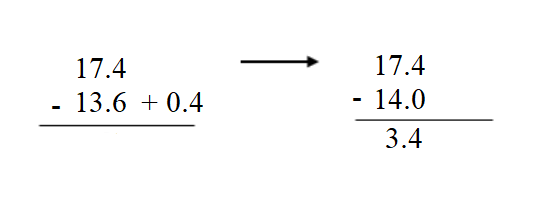
Subtract 0.4 more than 13.6, so you must add 0.4 to 3.4 to find the answer.

Question 4.
29.8 – 2.27 = _____
Answer:
29.8 – 2.27 = 27.53.
Explanation:

Subtract 0.03 more than 2.27, so you must add 0.03 to 27.50 to find the answer.

Apply and Grow: Practice
Use mental math to find the sum or difference.
Question 5.
1.25 + 2.45 + 1.75 = _____
Answer:
So, 1.25 + 2.45 + 1.75 = 5.45.
Explanation:
1.25 + 2.45 + 1.75 = ???
Notice that 1.25 and 1.75 are compatible numbers. Use addition properties to rewrite the problem.
1.25 + 2.45 + 1.75 = 2.45 + 1.25 + 1.75 Commutative Property
= 2.45 + (1.25 + 1.75) Associative Property
= 2.45 + 3.00
= 5.45.
Question 6.
8.4 + 6.15 + 2.6 = ______
Answer:
So, 8.4 + 6.15 + 2.6 = 17.15.
Explanation:
8.4 + 6.15 + 2.6 = ???
Notice that 8.4 and 2.6 are compatible numbers. Use addition properties to rewrite the problem.
8.4 + 6.15 + 2.6 = 6.15 + 8.4 + 2.6 Commutative Property
= 6.15 + (8.4 + 2.6) Associative Property
= 6.15 + 11.00
= 17.15
Question 7.
17.82 – 15.61 = _____
Answer:
17.82 – 15.61 = 2.21.
Explanation:

Subtract 0.09 more than 15.61, so you must add 0.09 to 2.12 to find the answer.

Question 8.
35.7 – 13.8 = _____
Answer:
35.7 – 13.8 = 21.9.
Explanation:

Subtract 0.2 more than 13.8, so you must add 0.2 to 21.7 to find the answer.

Question 9.
Two years ago, your friend was1.25 meters tall. Today, your friend is1.48 meters tall. How many meters did your friend grow?
Answer:
Height my friend grew = 0.23 meters.
Explanation:
Height of my Friend two years ago = 1.25 meters
Height of my Friend today = 1.48 meters
Height my friend grew = Height of my Friend today – Height of my Friend two years ago
= 1.48 – 1.25
= 0.23 meters
Question 10.
Clothing items are donated to an organization. How many pounds of clothing are donated altogether?
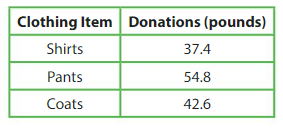
Answer:
Total weight of all clothing donated together = 134.8 pounds.
Explanation:
Weight of Shirts donated = 37.4 pounds.
Weight of Pants donated = 54.8 pounds.
Weight of Coats donated = 42.6 pounds.
Total weight of all clothing donated together = Weight of Shirts donated + Weight of Pants donated + Weight of Coats donated
= 37.4 + 54.8 + 42.6
= 134.8 pounds.
Question 11.
Reasoning
Can you use the Commutative Property to find the difference of two decimals? Explain.
Answer:
Yes, we can Commutative Property to find the difference of two decimals because the methodology we doing is subtraction in between the numerals. So, there wont be any difference expect the points.
Question 12.
DIG DEEPER!
Use each digit from 1 through 8 once to complete the problem.

Answer:
Explanation:

Think and Grow: Modeling Real Life
Example
A city receives 75.5 inches of snowfall and 45.27 inches of rainfall in 1 year. How much more snowfall does the city receive than rainfall?

Use compensation to find the difference between the amounts of snowfall and rainfall: 75.5 – 45.27.

So, the city receives _______ inches more snowfall than rainfall.
Answer:
So, the city receives 30.23 inches more snowfall than rainfall.
Explanation:

Show and Grow
Question 13.
On average, a left-handed professional baseball player runs from home plate to first base in 4.2 seconds. The record is 3.1 seconds. How much faster is the record than the average time?

Answer:
1.1 seconds is faster the record than the average time.
Explanation:
Time taken on an average, a left-handed professional baseball player runs from home plate to first base = 4.2 seconds
Time of record = 3.1 seconds
Difference in the time = Time taken on an average, a left-handed professional baseball player runs from home plate to first base – Time of record
= 4.2 – 3.1
= 1.1 seconds
Question 14.
DIG DEEPER!
The distances of each part of a triathlon are shown in the table. What is the total distance? How many more miles are traveled on land than in water?

Answer:
Total Distance travelled on land than in water = 30.07 miles.
Explanation:
Distance travelled to Swimming = 0.93 miles
Distance travelled on Bike = 24.8 miles
Distance travelled by Running = 6.2 miles
Total Distance travelled on land = Distance travelled on Bike – Distance travelled by Running
= 24.8 + 6.2
= 31 miles
Total Distance travelled on land than in water = Total Distance travelled on land – Distance travelled to Swimming
= 31 – 0.93
= 30.07 miles
Question 15.
DIG DEEPER!
You paint a meter stick for a craft. You paint 30.7 centimeters blue and 67.9 centimeters green. How many millimeters are not painted?
Answer:
Length of meter stick not painted = 14 millimeters
Explanation:
Length of blue paint painted on meter stick = 30.7 centimeters
Length of green paint painted on meter stick = 67.9 centimeters
Total length of meter stick painted = Length of blue paint painted on meter stick + Length of green paint painted on meter stick
= 30.7 + 67.9
= 98.6 centimeters
Conversion:
1 meter = 100 centimeters
Length of meter stick not painted = 100 centimeters – 98.6 centimeters = 1.4 centimeters.
1 centimeter = 10 millimeters
1.4 centimeter = ???
cross multiplication:
1.4 × 10 ÷ 1
= 14 ÷ 1
= 14 millimeters.
Use Mental Maths to Add or Subtract Decimals Homework & Practice 3.6
Use mental math to find the sum or difference
Question 1.
2.73 + 2.14 = ______
Answer:
2.73 + 2.14 = 4.87.
Explanation:

Add 0.06 more than 2.14, so you must subtract 0.06 to 4.93 to find the answer.

Question 2.
54.3 + 14.1 = ______
Answer:
54.3 + 14.1 = 68.40
Explanation:

Add 0.9 more than 14.1, so you must subtract 0.9 to 69.3 to find the answer.

Question 3.
19.86 – 7.2 = ______
Answer:
Explanation:

Subtract 0.8 more than 7.2, so you must add 0.8 to 11.86 to find the answer.

Question 4.
41.19 – 0.58 = _______
Answer:
41.19 – 0.58 =
Explanation:

Subtract 0.02 more than 0.58 , so you must add 0.02 to 40.59 to find the answer.

Question 5.
6.5 + 2.32 + 1.5 = _____
Answer:
6.5 + 2.32 + 1.5 = 10.32.
Explanation:
Notice that 6.5 and 1.5 are compatible numbers. Use addition properties to rewrite the problem.
6.5 + 2.32 + 1.5 = 2.32 + 6.5 + 1.5 Commutative Property
= 2.32 + (6.5 + 1.5) Associative Property
= 2.32 + 8.0
= 10.32.
Explanation:
Question 6.
2.25 – 1.15 = ______
Answer:
2.25 – 1.15 = 1.10.
Explanation:

Subtract 0.05 more than 1.15 , so you must add 0.05 to 1.05 to find the answer.

Question 7.
YOU BE THE TEACHER
Your friend finds 23.74 – 13.18. Is your friend correct? Explain.

Answer:
My Friend answer is correct because he used mental math to do the sum of the given numbers.
Explanation:

Question 8.
Writing
Describe a situation when you would use the Commutative Property to add decimals using mental math.
Answer:
The Commutative Property of Addition states that the order of the addends does not change the sum.
Let’s test the property using simple whole numbers.
4+5+9=18 4+9+5=18 5+4+9=18 5+9+4=18 9+5+4=18 9+4+5=18
As you can see, we can add the three addends (4, 5, and 9) in many different orders. The Commutative Property of Addition works also works for four, five, six addends, and it works for decimal addends, too.
Question 9.
DIG DEEPER!
Use mental math to find the missing number.
Answer:
Question 10.
Modeling Real Life
How much wider is the wingspan of the albatross than the length of an 8.89-foot-long alligator?

Answer:
2.06 feet wider is the wingspan of the albatross than the length of an 8.89-foot-long alligator.
Explanation:
Length of Albatross wingspan = 10.95 feet
Length of long Alligator = 8.89 foot
Difference:
Length of Albatross wingspan – Length of long Alligator
= 10.95 – 8.89
= 2.06 feet
Question 11.
Modeling Real Life
Your friend buys 3.5 meters of blue ribbon, 2.25 meters of red ribbon, and 3.75 meters of white ribbon. How much ribbon does she buy in all?
Answer:
Total Length of all ribbons = 9.50 meters.
Explanation:
Length of blue ribbon = 3.5 meters
Length of red ribbon = 2.25 meters
Length of white ribbon = 3.75 meters
Total Length of all ribbons = Length of blue ribbon + Length of red ribbon + Length of white ribbon
= 3.5 + 2.25 + 3.75
= 5.75 + 3.75
= 9.50 meters
Review & Refresh
Use the figure.
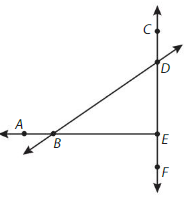
Question 12.
Name a line segment.
Answer:
Line segment = CD or DE or EF
Explanation:
In geometry, a line segment is a part of a line that is bounded by two distinct end points , and contains every point on the line between its endpoints.
Question 13.
Name two different rays.
Answer:
EF and AB are two different Rays.
Explanation:
In geometry, a ray can be defined as a part of a line that has a fixed starting point but no end point. It can extend infinitely in one direction.
Question 14.
Name two different lines.
Answer:
EA and DF are different lines.
Explanation:
In geometry, a line can be defined as a straight one- dimensional figure that has no thickness and extends endlessly in both directions. It is often described as the shortest distance between any two points.
Lesson 3.7 Problem Solving: Money
Explore and Grow
Use addition or subtraction to make several item Cost conclusions about the prices of the items in the table.

Answer:
Total cost of all items = $180.77.
Explanation:
Cost of Video game = $54.93
Cost of Selfie stick = $15.08
Cost of Power Bank = $27.36
Cost of Speaker = $83.40
Total cost of all items = Cost of Video game + Cost of Selfie stick + Cost of Power Bank + Cost of Speaker
= $54.93 + $15.08 + $27.36 + $83.40
= $70.01 + $27.36 + $83.40
= $97.37 + $83.40
= $180.77.
Precision
Switch papers with your partner. Check your partner’s work for reasonableness.
Answer: Both the answers are reasonableness because the answers procedure is same and answers match.
Think and Grow: Problem Solving: Money
Example
You have$11.83. You earn $13.75 more doing chores. Then you buy headphones for $12.39. How much money do you have left?
Understand the Problem
What do you know?
• You have $11.83.
• You earn $13.75 more.
• You buy headphones for $12.39.
What do you need to find?
• You need to find how much money you have left.
Make a Plan
How will you solve?
Write and solve an equation to find the amount of money you have left.
Solve

Let s represent the amount of money you have left.
s = 11.83 + 13.75 – 12.39
= ______ − 12.39
= ______
You have $ ______ left.
Answer:
Amount left out with me = $13.19.
Explanation:
Amount of money I have = $11.83
Amount of money I have earned = $13.75
Cost of Headphones = $12.39
Amount left out with me = Amount of money I have + Amount of money I have earned + Cost of Headphones
= $11.83 + $13.75 – $12.39
= $25.58 – $12.39
= $13.19.
Show and Grow
Question 1.
You have $32.63. You earn $28.42 more washing windows. Then you buy a video game for $35.95.How much money do you have left?

Answer:
Amount of money left with me = $25.1.
Explanation:
Amount of money I have = $32.63
Amount of money earned = $28.42
Cost of Video game = $35.95
Amount of money left with me = Amount of money I have + Amount of money earned + Cost of Video game
= $32.63 + $28.42 – $35.95
= $61.05 – $35.95
= $25.1.
Apply and Grow: Practice
Understand the problem. What do you know? What do you need to find? Explain.
Question 2.
You buy 3 cell phone games that cost $5 each and an in-game purchase for $1.69. How much money do you spend?
Answer:
Total Cost of money spent = $16.69
Explanation:
Cost of 3 cell phones games = 3 × $5 = $15
Cost of an in-game = $1.69
Total Cost of money spent = Cost of 3 cell phones games + Cost of an in-game
= $15 + $1.69
= $16.69.
Question 3.
Newton buys a movie ticket that costs $4.50, a drink that costs $2.25, and a bag of popcorn that costs $4.75. How much money does Newton spend?

Answer:
Total amount spent = $11.50.
Explanation:
Cost of movie ticket = $4.50
Cost of a drink = $2.25
Cost of a bag of popcorn = $4.75
Total amount spent = Cost of movie ticket + Cost of a drink + Cost of a bag of popcorn
= $4.50 + $2.25 + $4.75
= $6.75 + $4.75
= $11.50.
Understand the problem. Then make a plan. How will you solve? Explain.
Question 4.
Your friend buys a remote control car for$17.89 and some batteries for $5.49. He gives the cashier $25. How much change does he receive?
Answer:
Amount of change he receives = $1.62.
Explanation:
Cost of remote control car = $17.89
Cost of Some batteries = $5.49
Money given to cashier = $25
Amount of change he receives = Money given to cashier- Cost of remote control car + Cost of Some batteries –
= $25 – $17.89 + $5.49
= $25 – $23.38
= $1.62.
Question 5.
Your cousin has $156.34 in his bank account. He withdraws $15.50 one day and $6.75 the next day. How much money is in his bank account now?
Answer:
Amount left in his bank account = $134.09.
Explanation:
Amount of money my cousin has in bank account = $156.34
Amount of money he withdraws one day = $15.50
Amount of money he withdraws next day = $6.75
Amount left in his bank account = Amount of money my cousin has in bank account – Amount of money he withdraws one day –
Amount of money he withdraws next day
= $156.34 – $15.50 – $6.75
= $156.34 – $22.25
= $134.09.
Question 6.
Adult admission to open skate night costs $5.75. Admission for children under 13 costs $1.50 less than adult admission. What is the total admission cost for two 12-year-olds?

Answer:
Total admission cost for two 12-year-olds = $10.
Explanation:
Cost of Adult admission to open skate night = $5.75
Cost of Admission for children under 13 costs $1.50 less than adult admission
=> $5.75 – $1.50
=> $4.25
Total admission cost for two 12-year-olds = Cost of Adult admission to open skate night + Cost of Admission for children under 13
= $5.75 + $4.25
= $10.
Question 7.
Descartes buys a book for $14.99 and a bookmark. He pays with a $20 bill and receives $3.96 in change. How much does the bookmark cost?
Answer:
Cost of the book mark = $1.05.
Explanation:
Cost of the book and a bookmark = $14.99
Amount paid by a bill = $20
Amount of money received as change = $3.96
Cost of the book mark = Amount paid by a bill – Cost of the book and a bookmark – Amount of money received as change
= $20 – $14.99 – $3.96
= $5.01 – $3.96
= $1.05.
Think and Grow: Modeling Real Life
Example
You pay for colored pencils, a coloring book, and a pencil sharpener with two $20 bills. Your change is $17.42. How much does the pencil sharpener cost?
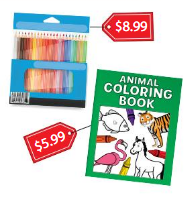
Think: What do you know? What do you need to find? How will you solve?
Write and solve an equation to find the cost of the pencil sharpener.

Let c represent the cost of the pencil sharpener.
c = 40 – (8.99 + 5.99) – 17.42
= 40 – ______ – 17.42
= ____ − 17.42
= _____
The pencil sharpener costs $ _____.
Answer:
Cost of the pencil sharpener costs = $7.6.
Explanation:
Cost of the coloring book = $5.99
Cost of the colored pencils = $8.99
Amount received as change = $17.42
Amount paid in two bills = $20 × 2 = $40
Cost of the pencil sharpener costs = Amount paid in two bills – (Cost of the coloring book + Cost of the colored pencils) + Amount received as change
= $40 – ( $5.99 + $8.99 ) – $17.42
= $40 – $14.98 – $17.42
= $25.02 – $17.42
= $7.6.
Show and Grow
Question 8.
Newton pays for a new collar, a bag of dog food, and a box of bones with four $5 bills. His change is $4.02. How much does the box of bones cost?

Answer:
Cost of the box of bones = $3.39.
Explanation:
Cost of a bag of dog food = $5.49
Cost of a dog’s new collar = $7.10
Amount of change he receives = $4.02
Amount paid in four bills = $5 × 4 = $20.
Cost of the box of bones = Amount paid in four bills – (Cost of a bag of dog food – Cost of a dog’s new collar) – Amount of change he receives
= $20 – ($5.49 + $7.10) – $4.02
= $20 – $12.59 – $4.02
= $7.41 -$4.02
= $3.39.
Question 9.
DIG DEEPER!
Your friend buys the scooter and the helmet. Your friend has two gift cards that are worth the same amount. Your friend uses both gift cards and pays an additional $2.49. What is the amount on each gift card?

Answer:
Cost of the each gift cards = $75.
Explanation:
Cost of the Helmet = $27.50
Cost of the Scooter = $124.99
Amount of money paid additionally = $2.49
Let the gifts cards be X.
= 2Cost of the each gift cards + Amount of money paid additionally = (Cost of the Helmet + Cost of the Scooter)
=> 2X + $2.49 = $27.50 + $124.99
=> 2X + $2.49 = $152.49
=> 2X = $152.49 – $2.49
=> 2X = $150.00
=> X = $150.00 ÷ 2
=> X = $75.
Problem Solving: Money Homework & Practice 3.7
Understand the problem. What do you know? What do you need to find? Explain.
Question 1.
A musician buys an electronic keyboard for $89.94 and 2 books of sheet music for $7.99 each. How much does she spend in all?
Answer:
Total cost of money spent = $105.92.
Explanation:
Cost of an electronic keyboard = $89.94
Cost of two books of sheet music = $7.99 × 2 = $15.98
Total cost of money spent = Cost of an electronic keyboard + Cost of two books of sheet music
= $89.94 + $15.98
= $105.92
Question 2.
You have$28.49. You spend $14.95 at a bowling alley. You win $35.00 for setting the record score for your age group. How much money do you have now?
Answer:
Amount of money I have now = $48.54.
Explanation:
Amount of money I have = $28.49
Amount spent at a bowling alley = $14.95
Amount of money won = $35.00
Amount of money I have now = Amount of money I have – Amount spent at a bowling alley + Amount of money won
=> $28.49 – $14.95 + $35.00
=> $13.54 + $35.00
=> $48.54.
Understand the problem. Then make a plan. How will you solve? Explain.
Question 3.
Newton wins a $50 gift card toa craft store. He uses the card to buy a scrapbook for $19.99 and a set of markers for $10.75. How much money is left on his gift card?
Answer:
Amount of money left on his gift card = $19.26.
Explanation:
Amount of money won for a gift card to a craft store = $50
Amount of money spent to buy a scrapbook by using card = $19.99
Amount of money spent to buy a set of markers by using card = $10.75
Amount of money left on his gift card = Amount of money won for a gift card to a craft store – (Amount of money spent to buy a scrapbook by using card + Amount of money spent to buy a set of markers by using card)
= $50 – ($19.99 + $10.75)
= $ 50 – $30.74
= $19.26.
Question 4.
A dancer buys a tutu for $48.75 and the ballet shoes. She gives the cashier $80. How much change does she receive?
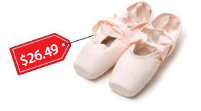
Answer:
Amount of change received = $4.76.
Explanation:
Cost of the ballet shoes = $26.49
Cost of the tutu = $48.75
Amount given to cashier = $80
Amount of change received = Amount given to cashier – (Cost of the tutu + Cost of the ballet shoes )
= $80 – ( $ 26.49 + $48.75)
= $80 – $75.24
= $4.76
Question 5.
A theater director buys props for$116.20 and costumes for $494.85. He has $194.27 left. How much money did he have to start?
Answer:
Amount of money he have started = $805.32.
Explanation:
Cost of props = $116.20
Cost of the costumes = $494.85
Amount left with him = $194.27
Amount of money he have started = Cost of the costumes + Cost of props + Amount left with him
= $116.20 + $494.85 + $194.27
= $611.05 + $194.27
= $805.32
Question 6.
Descartes uses a metal detector at a beach. He finds 3 quarters, 6 dimes,2 nickels, and 5 pennies. He drops1 quarter and 2 pennies into the water. Then he finds 4 more dimes. How much money does Descartes have now?
Answer:
Total amount of money Descartes have now = 163 pennies.
Explanation:
Number of dimes found = 6
Number of quarters found = 3
Number of pennies found = 5
Number of nickels found = 2
Number of quarters dropped into water= 1
Number of pennies dropped into water = 2
Number of dimes found later = 4
Conversion:
Total number of quarters = Number of quarters found – Number of quarters dropped into water
=> 3 – 1 = 2
Quarter into pennies
=> 1 Quarter = 25 pennies
=> 2 Quarter = 25 × 2 = 50 pennies.
Total number of dimes = Number of dimes found + Number of dimes found later
=> 6 +4 = 10
Dimes into pennies
=> 1 Dime = 10 pennies
=> 10 Dime = 10 × 10 = 100 pennies
Total number of Nickels = Number of nickels found
=> 2
Nickels into pennies
=> 1 Nickel = 5 pennies
=> 2 nickels = 2 × 5 = 10 pennies
Total Number of pennies = Number of pennies found – Number of pennies dropped into water
=> 5 – 2
=>3 pennies
Total amount of money Descartes have now = Total number of quarters + Total number of dimes + Total number of Nickels + Total Number of pennies
= 50 pennies + 100 pennies + 10 pennies + 3pennies
= 163 pennies.
Question 7.
DIG DEEPER!
Descartes wants to buy a ball launcher for Newton for $12.50. He has one $10 bill, two $5 bills, three $1 bills, and two quarters. Make a table to find four ways Descartes could pay for the ball launcher.

Answer:
Amount of change Descartes receives = $11.00.
Explanation:
Cost of a ball launcher = $12.50
Number of bills he has worth $10 = 1
Number of bills he has worth $5 = 2
Number of bills he has worth $1 = 3
Number of quarters he has = 2
Conversion:
Quarter into Dollars
1 Quarter = $0.25
=>2 Quarter = 0.25 × 2 = $0.50.
Amount given to cashier = Number of bills he has worth $10 + Number of bills he has worth $5 + Number of bills he has worth $1 +
Number of quarters he has
=> $10 + $5 + $5 + $1 + $1 + $1 + $0.50
=> $23.50
Amount of change Descartes receives = Amount given to cashier – Cost of a ball launcher
=> $23.50 – $12.50
= $11.00

Question 8.
Modeling Real Life
Your science teacher pays for an ultraviolet light, a beaker, and a glowing liquid kit with five $5 bills. The ultraviolet light costs $13.29. The beaker costs $7.99. Your teacher’s change is $0.77. What is the cost of the glowing liquid kit?

Answer:
Cost of the glowing liquid kit = $2.95
Explanation:
Cost of the ultraviolet light = $13.29
Cost of the beaker = $7.99
Amount of change teacher receives= $0.77
Your science teacher pays an ultraviolet light, a beaker, and a glowing liquid kit with five $5 bills
=> Cost of the ultraviolet light + Cost of the beaker + Cost of the glowing liquid kit + Amount of change teacher receives = 5 × $5
=> $13.29 + $7.99 + Cost of the glowing liquid kit + $0.77 = $25
=> $22.05 + Cost of the glowing liquid kit = $25
=> Cost of the glowing liquid kit = $25 – $22.05
=> Cost of the glowing liquid kit = $2.95
Review & Refresh
Find the equivalent length.
Question 9.
10 ft = _____ in.
Answer:
10 ft = 120 in.
Explanation:
Conversion:
1 feet = 12 inches
=> 10 feet = 10 × 12 =120 inches.
Question 10.
2 mi = ______ ft
Answer:
2 mi = 10560 ft
Explanation:
Conversion:
1 Mile = 5280 feet
2 mi = 5280 × 2 = 10560 ft
Question 11.
\(\frac{1}{3}\) yd = ______ ft
Answer:
\(\frac{1}{3}\) yd = \({1}\) feet.
Explanation:
Conversion:
1 Yard = 3 Feet
\(\frac{1}{3}\) yd = \(\frac{1}{3}\) yd × \({3}\) = \({1}\) feet
Add and Subtract Decimals Performance Task
The table shows the average amount of rainfall each month Rainfall in Mobile, Alabama. Mobile, Alabama

Question 1.
About how many inches of rainfall does the city get Average Month Rainfall during June, July, and August combined?
Answer:
Average rainfall during June, July, and August = 6.77 inches.
Explanation:
Rainfall rate in June month = 6.10 inches
Rainfall rate in July month = 7.24 inches
Rainfall rate in August month = 6.97 inches
Average rainfall during June, July, and August = Rainfall rate in June month + Rainfall rate in July month + Rainfall rate in August month ÷ 3
= 6.10 + 7.24 + 6.97 ÷ 3
= 20.31 ÷ 3
= 6.77 inches
Question 2.
How many more inches of rainfall does the city usually get in July than in October?
Answer:
3.54 inches. of Rainfall is more in the city in July month than in October month.
Explanation:
Rainfall in July month = 7.24 inches
Rainfall in October month = 3.70 inches
Comparison:
= Rainfall in July month – Rainfall in October month
= 7.24 – 3.70
= 3.54 inches.
Question 3.
a. Round each rainfall amount to the nearest tenth. About how many inches of rainfall does Mobile get each year?
b. How can you check whether your answer is reasonable?
Answer:
a) The total Rainfall Mobile gets each year = 66.22 inches.
b) We can check the answer is reasonable or not by rounding it to its nearest 10.
Explanation:
a) Round each rainfall amount to the nearest tenth.

5 and above rainfall rate is said to be rounded to its nearest 10 as 10.

b)
We can check the answer is reasonable or not by rounding it to its nearest 10.
63 is close reasonable to 66.22.
Question 4.
The average yearly amount of rainfall in Seattle, Washington, is about 3 feet.
a. Write an expression to find about how many more inches of rain Mobile, Alabama, usually gets than Seattle each year.

b. Seattle is known for being one of the rainiest cities in the United States, even though it usually gets less rain than Mobile each year. Why do you think Seattle is known as the rainiest city?
Answer:
a) 30.22 inches of rain Mobile, Alabama, usually gets than Seattle each year.
b) Seattle is known for being one of the rainiest cities in the United States, even though it usually gets less rain than Mobile each year. This means that Seattle has more frequent rain, but the light rain results in low totals than compared to rainfall in Mobile, Alabama.
Explanation:
a)The average yearly amount of rainfall in Seattle, Washington, is about 3 feet.
=> Average Rainfall of Seattle, Washington = 3 feet.
Total Average of Rainfall in Mobile, Alabama = 66.22 inches
Difference :
1 feet = 12 inches
=> 3 feet = 12 × 3 = 36 inches
Total Average of Rainfall in Mobile, Alabama – Average Rainfall of Seattle, Washington
= 66.22 – 36
= 30.22 inches
b)
Seattle is known for being one of the rainiest cities in the United States, even though it usually gets less rain than Mobile each year. This means that Seattle has more frequent rain, but the light rain results in low totals than compared to rainfall in Mobile, Alabama.
Add and Subtract Decimals Activity
Decimal Dots
Directions:
1. Players take turns connecting two dots, each using a different color.
2. On your turn, connect two dots, vertically or horizontally. If you close a square around an expression, then evaluate the expression. If you do not close a square, your turn is over.
3. Continue playing until all expressions are evaluated.
4. The player with the most evaluated expressions wins!

Add and Subtract Decimals Chapter Practice
3.1 Estimate the Sum or Differences.
Estimate the sum or difference.
Question 1.

Answer:
741.26 + 103.75 = 845.31.
Explanation:

Question 2.

Answer:
89.5 – 41.8 = 47.7.
Explanation:

Question 3.
13.47 – 9.82
Answer:
13.47 – 9.82 = 3.65.
Explanation:

Question 4.
64.9 + 17.5
Answer:
64.9 + 17.5 = 82.4.
Explanation:

Question 5.
Number Sense
Descartes estimates a difference by rounding each number to the nearest whole number. His estimate is 6. Which problems could he have estimated?
97.5 – 91.8
10.3 – 4.6
23.7 – 18.1
7.2 – 0.8
Answer:
His Problems of estimation to 6 are 97.5 – 91.8 and 7.2 – 0.8.
Explanation:
First round the numbers to nearest whole number later , find the difference:
97.5 – 91.8 = 98 – 92 = 6
10.3 – 4.6 = 10 – 5 = 5
23.7 – 18.1 = 23 – 18 = 5
7.2 – 0.8 = 7 – 1 = 6
3.2 Use Models to Add or Subtract Decimals
Make a quick sketch to find the sum or difference.
Question 6.
0.27 + 0.19
Answer:
0.27 + 0.19 = 0.46.
Explanation:

Question 7.
2.52 – 1.36 = ______
Answer:
2.52 – 1.36 = 1.16.
Explanation:

3.3 Add Decimals
Find the sum. Check whether your answer is reasonable.
Question 8.

Answer:
10.36 + 0.29 = 10.65.
10.65 is reasonable.
Explanation:

Check:
10.65 – 0.29
=10.36.
Question 9.

Answer:
461.2 + 78.5 = 539.7
539.7 is reasonable.
Explanation:

Check:
539.7 – 78.5
= 461.2.
Question 10.
97.65 + 23.08 = _____
Answer:
97.65 + 23.08 = 120.73.
120.73 is reasonable.
Explanation:

Check:
120.73 – 23.08
= 97.65.
Question 11.
63.39 + 4.05 = _____
Answer:
63.39 + 4.05 = 67.44.
67.44 is a reasonable.
Explanation:
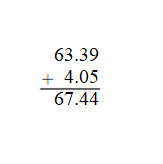
Check:
67.44 – 4.05
=63.39.
Question 12.
Modeling Real Life
You want to conduct an experiment. You need 0.5 cup of water and the same amount of oil. How many cups of liquid do you need for the experiment?
Answer:
Total number of cups required of liquid = 1 cup.
Explanation:
Amount of water required = 0.5 cup
Amount of oil required = 0.5 cup
Total number of cups required of liquid = Amount of water required + Amount of oil required
= 0.5 + 0.5
= 1 cup
3.4 Subtract Decimals
Find the difference. Then check your answer.
Question 13.

Answer:
86.5 – 49.4 = 37.1.
Explanation:

Check:
37.1 + 49.4
= 86.5
Question 14.

Answer:
37.82 – 5.07 = 32.75.
Explanation:

Check :
32.75 + 5.07
= 37.82.
Question 15.
582.58 – 33.21 = _____
Answer:
582.58 – 33.21 = 549.37.
Explanation:

Check:
549.37 + 33.21
= 582.58.
Question 16.
99.2 – 8.6 = _____
Answer:
99.2 – 8.6 = 90.6.
Explanation:
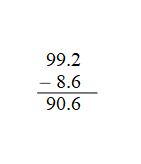
Check:
90.6 + 8.6
= 99.2.
3.5 Add and Subtract Decimals
Evaluate. Check whether your answer is reasonable.
Question 17.
9.28 – 5.4 – 2.75 = _____
Answer:
9.28 – 5.4 – 2.75 = 1.13.
1.13 is reasonable.
Explanation:
9.28 – 5.4 – 2.75 = ???
9.28 – 5.4 – 2.75 = 3.88 – 2.75 = 1.13.
Check:
1.13 + 2.75 + 5.4
= 3.88 + 5.4
= 9.28.
Question 18.
2 + 18.6 – 7.9 = ______
Answer:
2 + 18.6 – 7.9 = 12.7.
12.7 is reasonable.
Explanation:
2 + 18.6 – 7.9 = ???
2 + 18.6 – 7.9
= 20.6 – 7.9
= 12.7
Check:
12.7 + 7.9 – 18.6
= 20.6 – 18.6
= 2
Question 19.
26 – 0.8 + 13.1 = ______
Answer:
26 – 0.8 + 13.1 = 38.3
38.3 is reasonable.
Explanation:
26 – 0.8 + 13.1 = ???
26 – 0.8 + 13.1
= 25.2 + 13.1
= 38.3
Check:
38.3 – 13.1 + 0.8
= 25.2 + 0.8
= 26
Question 20.
1.72 + 4 + 35.68
Answer:
1.72 + 4 + 35.68 = 41.4
41.4 is reasonable.
Explanation:
1.72 + 4 + 35.68 = ???
1.72 + 4 + 35.68
= 5.72 + 35.68
= 41.4
Check:
41.4 – 35.68 -4
= 5.72 – 4
= 1.72
Question 21.
Modeling Real Life
How many inches of snowfall Month Snowfall (inches)are recorded altogether?
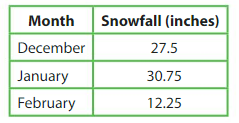
Answer:
Total Snowfall in all three months = 70.50 inches.
Explanation:
Snowfall in the month of December = 27.5
Snowfall in the month of January = 30.75
Snowfall in the month of February = 12.25
Total Snowfall in all three months = Snowfall in the month of December – Snowfall in the month of January – Snowfall in the month of February
= 27.5 + 30.75 + 12.25
= 58.25 + 12.25
= 70.50 inches.
3.6 Use Mental Maths to Add or Subtract Decimals
Use mental math to find the sum or difference.
Question 22.
6.3 + 2.98 + 5.7 = ______
Answer:
6.3 + 2.98 + 5.7 = 14.98.
Explanation:
Given 6.3 + 2.98 + 5.7 =
6.3 and 5.7 are compatible numbers. Use addition properties to rewrite the problem.
6.3 + 2.98 + 5.7 = 2.98 + (6.3 + 5.7) Associative Property
= 2.98 + 12
= 14.98.
Question 23.
9.1 + 4.57 + 8.03 = _____
Answer:
9.1 + 4.57 + 8.03 = 21.7.
Explanation:
Given 9.1 + 4.57 + 8.03
4.57 and 8.03 are compatible numbers. Use addition properties to rewrite the problem.
9.1 + 4.57 + 8.03 = 9.1 + (4.57 + 8.03) Associative Property
= 9.1 + 12.6
= 21.7
Question 24.
25.7 – 14.9 = _____
Answer:
25.7 – 14.9 = 10.8.
Explanation:

Subtract 0.1 more than 14.9 , so you must Add 0.1 to 10.7 to find the answer.

Question 25.
9.24 – 2.67 = _____
Answer:
9.24 – 2.67 = 6.57.
Explanation:

Subtract 0.03 more than 2.67 , so you must Add 0.03 to 6.54 to find the answer.

Question 26.
Number Sense
Use mental math to find the missing number.
9.2 + n + 2.5 = 15.8
Answer:
Explanation:
Given 6.5 + 3.1 + 3.5,
6.5 and 3.5 are compatible numbers. Use addition properties to rewrite the problem.
6.5 + 3.1 + 3.5 = 3.1 + (6.5 + 3.5) Associative Property
= 3.1 + 10
= 13.1
3.7 Problem Solving: Money
Question 27.
Newton buys a board game for $9.99 and a pack of trading cards for $2.99. He gives the cashier a $20 bill. How much change does he receive?

Answer:
Amount of money change received = $7.02.
Explanation:
Cost of a board game = $9.99
Cost of a pack of trading cards = $2.99
Amount of bills paid to cashier = $20
Amount of money change received = Amount of bills paid to cashier – ( Cost of a pack of trading cards + Cost of a board game )
= $20 – ( $9.99 + $2.99 )
= $20 – $12.98
= $7.02.
Question 28.
Descartes has $378.97 in his bank account. He withdraws $59.50 one day and then deposits $20.44 the next day. How much money is in his bank account now?
Answer:
Amount of money left in the bank account = $339.91.
Explanation:
Amount of money Descartes has in his bank account= $378.97
Amount of money withdrawn = $59.50
Amount of money he deposited later = $20.44
Amount of money left in the bank account = Amount of money Descartes has in his bank account – Amount of money withdrawn + Amount of money he deposited later
= $378.97 – $59.50 + $20.44
= $319.47 + $20.44
= $339.91
Question 29.
Modeling Real Life
A bowling alley charges $7.50 for each person to bowl and $2.25 to rent a pair of shoes. How much does it cost you and your friend to bowl and rent shoes?
Answer:
Amount of money charged for me and my friend to bowl and rent shoes = $9.75.
Explanation:
Amount of money charged for each person to bowl = $7.50
Amount of money charged as rent for a pair of shoes = $2.25
Amount of money charged for me and my friend to bowl and rent shoes = Amount of money charged for each person to bowl +
Amount of money charged as rent for a pair of shoes
= $7.50 + $2.25
= $9.75.
Question 30.
Reasoning
Your friend wants to buy a magic kit for $18.75. He has two $10 bills, one $5 bill, four $1 bills, and 3 quarters. Make a table to find three ways your friend could pay for the magic kit.

Answer:

Explanation:
Cost of the a magic kit = $18.75
Number of $10 bills my friend has = 2 = $10 × 2 = $ 20.
Number of $5 bills my friend has = 1 = $5 × 1 = $5.
Number of $1 bills my friend has = 4 = $ 1 × 4 = $ 4.
Number of Quarters my friend has = 3
Conversion:
1 Quarter = 0.25 dollar
=> 3 Quarter = 3 × 0.25 = $0.75.
Amount of money my friend has = Number of $10 bills my friend has + Number of $5 bills my friend has + Number of $1 bills my friend has + Number of Quarters my friend has
= $20 + $5 + $4 + $0.75
= $ 25 + $4 + $0.75
= $29 + $0.75
= $29.75.
Add and Subtract Decimals Cumulative Practice
Question 1.
Using the order of operations, which operation should you perform last to evaluate the expression?
(4 × 6) + (100 ÷ 10) – (3 + 4)
A. addition
B. subtraction
C. multiplication
D. division
Answer:
A. addition.
Explanation:
Given Equation:
According to DMAS rule:
First Division:
=> (4 × 6) + (100 ÷ 10) – (3 + 4)
=> (4 × 6) + 10 – (3 + 4)
Second Multiplication:
=> (4 × 6) + 10 – (3 + 4)
=> 24 + 10 – (3 + 4)
Third Addition:
=> 24 + 10 – (3 + 4)
=> 24 + 10 + 1
=> 34 +1
=> 35.
Question 2.
Which numbers round to 4 when rounded to the nearest whole number?

Answer:
4.03, 3.98, 4.1 are the numbers round to 4 when rounded to the nearest whole number.
Explanation:
Round all options to nearest whole number:
4.03 – 4
4.5 – 5
44.2 – 44
3.98 – 4
3.46 – 3
4.1 – 4
Question 3.
Which bike trail does the figure show?

A. River Run
B. Straight and Fast
C. Twist and Turn
D. Wood Way
Answer:
Total distance from A to E = 4.5 km
=> River Run bike trail the figure shows.
Explanation:
First add all the distances given in the map:

Distance from A to B = 1.75 km
Distance from B to C = 1.0 km
Distance from C to D = 0.5 km
Distance from D to E = 0.75 km
Distance from E to A = 0.5 km
Total distance from A to E = Distance from A to B + Distance from B to C + Distance from C to D + Distance from D to E
Distance from E to A
= 1.75 + 1.0 + 0.5 + 0.75 + 0.5
= 2.75 + + 0.5 + 0.75 + 0.5
= 3.0 + 0.75 + 0.5
= 3.75 + 0.5
= 4.25 km.
Question 4.
What is 0.045 written as a fraction?
A. \(\frac{45}{100}\)
B. \(\frac{1,000}{45}\)
C. \(\frac{45}{1,000}\)
D. \(\frac{450}{1,000}\)
Answer:
C. \(\frac{45}{1,000}\)
Explanation:
0.045 fraction= 45 ÷ 1000.
Question 5.
A recipe calls for 3 eggs. Newton makes 5 batches of the recipe, and Descartes makes 2 batches of the recipe. Which expressions can you use to determine how many eggs Newton and Descartes use in all?

Answer:
The Expression used = (5 × 3) + ( 2 × 2 ).
Explanation:
A recipe calls for 3 eggs.
Number of recipe batches Newton makes = 5
=>Number of eggs used by Newton = 5 × 3
Number of recipe batches Descartes makes = 2
=>Number of eggs used by Descartes = 2 × 2
Number of eggs both used = Number of eggs used by Newton + Number of eggs used by Descartes
= (5 × 3) + ( 2 × 2 )
= 15 + 4
= 19.
Question 6.
What is the difference of 97.63 and 4.98?

Answer:
97.63 -4.98 = 92.65.
Explanation:
Difference:
97.63 -4.98 =???

Question 7.
What is 60.25 written in word form?
A. sixty twenty-five
B. sixty and twenty-five tenths
C. sixty and twenty-five
D. sixty and twenty-five hundredths
Answer:
D. sixty and twenty-five hundredths
Explanation:
Number name of 60.25 = ????
Question 8.
Find 55.6 – 3.97.
A. 1.59
B. 51.63
C. 52.37
D. 59.57
Answer:
55.6 – 3.97 = 51.63.
Explanation:
55.6 – 3.97 = ???

Question 9.
What is the value of the expression?
[21 ÷ (3 + 4)] – 2
A. 9
B. 4 R1
C. 1
D. 2
Answer:
C. 1
Explanation:
[21 ÷ (3 + 4)] – 2
= [21 ÷ (7)] – 2
= 3 – 2
=1
Question 10.
Which statement correctly compares the decimals?

Answer:
A. 0.1 > 0.111.
Explanation:

Question 11.
What is the value of n?
n – 9.02 = 3.85
A. 12.87
B. 5.17
C. 3.87
D. 12
Answer:
n = 12.87.
Explanation:
n = ??
n – 9.02 = 3.85
n = 3.85 + 9.02
n = 12.87.
Question 12.
Which property is shown?
35 + (15 + 7) = (35 + 15) + 7
A. Associative Property of Addition
B. Commutative Property
C. Distributive Property
D. Associative Property of Multiplication
Answer:
A. Associative Property of Addition.
Explanation:
The associative property states that you can add or multiply regardless of how the numbers are grouped.
35 + (15 + 7) = (35 + 15) + 7
Question 13.
Newton estimates a sum by rounding each number to the nearest ten. His estimate is 140. Which problems could he have estimated?

Answer:
123.5 + 19.6, 87.6 + 50.4, 65.43 + 71.59 problem he have estimated.
Explanation:
First, find all sums of given Equations:
123.5 + 19.6 = 124 + 20 = 144.
87.6 + 50.4 = 88 + 50 = 138.
65.43 + 71.59 = 65 + 72 = 137.
98.03 + 34.56 = 98 + 34 = 132.
Question 14.
What is five hundred four thousand, eleven written in standard form?
A. 54,011
B. 54,110
C. 504,110
D. 504,011
Answer:
Explanation:
Question 15.
Which expressions have a value of 8?

Answer:
30 ÷ ( 5 × 2 ) + 5, 4 × ( 5 – 3 ) , (16 ÷ 8) + ( 3 × 2 ) are expressions having a value of 8.
Explanation:
First, solve the equations:
30 ÷ ( 5 × 2 ) + 5 = 30 ÷ 10 + 5 = 3 + 5 = 8.
55 – 7 ÷ 6 = 55 – 1.167 = 53.833.
4 × ( 5 – 3 ) = 4 × 2 = 8.
(16 ÷ 8) + ( 3 × 2 ) = 2 + 6 = 8.
Question 16.
Descartes wins a $50 gift card to a sporting goods store. He uses the card to buy two baseballs for $1.79 each, a baseball glove for $14.99, and a baseball bat for $12.25. About how much money is left on his gift card?
A. $21
B. $19
C. $31
D. $18
Answer:
Total amount left on his gift card= $19.18.
Explanation:
Amount of gift card won for a sporting goods store = $50
Cost of the two baseballs = $1.79 each = > 2 × 1.79 = $3.58
Cost of a baseball glove = $14.99
Cost of a baseball bat = $12.25
Total amount left on his gift card= Amount of gift card won for a sporting goods store – (Cost of the two baseballs + Cost of a baseball glove + Cost of a baseball bat )
= $50 – ( $3.58 + $14.99 + $12.25)
= $50 – ( $18.57 + $12.25)
= $50 – $30.82
= $19.18.
Question 17.
What is the value of 4× 105?
A. 45
B. 400,000
C. 40,000
D. 200
Answer:
4× 105 = B. 400,000.
Explanation:
4× 105
= 4 × 10 ×10 × 10 × 10 × 10
= 4 × 100000
= 400,000
Question 18.
The dimensions of two rectangles are shown.

Part A Write an expression to determine how much greater the area of the green rectangle is than the area of the yellow rectangle.
Part B Evaluate the expression.
Part C Explain how you used order of operations to evaluate the expression.
Answer:
Part A : Area of the green rectangle > Area of the yellow rectangle
9ft × 8ft > 7ft × 5ft
Part B: Evaluate the expression.
9ft × 8ft > 7ft × 5ft
=> 72ft > 35ft
Part C:
I used the order of DMAS rule.
Division, Multiplication, Addition and Subtraction order of operations to evaluate the expression
Explanation:
Part A:
Length of the green rectangle = 9ft
Width of the green rectangle = 8ft
Area of the green rectangle = Length of the green rectangle × Width of the green rectangle
= 9ft × 8ft
= 72 ft.
Length of the yellow rectangle = 7ft
Width of the yellow rectangle = 5ft
Area of the yellow rectangle = Length of the yellow rectangle × Width of the yellow rectangle
= 7ft × 5ft
= 35ft
Part C: Explain how you used order of operations to evaluate the expression.
I used the order of DMAS rule.
Division, Multiplication, Addition and Subtraction order of operations to evaluate the expression.
Add and Subtract Decimals STEAM Performance Task
Students can buy pencils, notebooks, and other supplies at your school’s student store. The table below shows the money in the student store account.


Question 1.
Line 1 shows how much money was in the account at the start of the school year. Line 2 shows a payment of $85.89 for supplies. Complete the account balance for Line 2.
Answer:
Amount of money left in the account = $14.11.

Explanation:
Amount in the account at the start of the school year = $100.00
Amount in the account used for supplies = $85.89
Amount of money left in the account = Amount in the account at the start of the school year – Amount in the account used for supplies = $100.00 – $85.89
= $ 14.11
Question 2.
The store has forty-four dollars and thirty cents in sales for the first week and thirty-two dollars and twelve cents in sales for the second week. The sales each week are deposited into the student store account. Fill in the deposits and balances for Lines 3 and 4.
Answer:
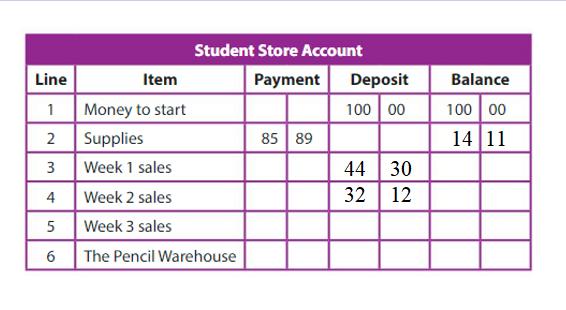
Explanation:
Amount of money received in sales for the first week = forty-four dollars and thirty cents = $44.30
Amount of money received in sales for the second week = thirty-two dollars and twelve cents = $ 32.12
Question 3.
The balance after the third week of sales is $115.68. How much money did the store have in sales during the third week? Fill in the deposit and balance for Line 5.
Answer:
Amount of money received in sales for the third week = $25.15.

Explanation:
Amount of money balance after the third week of sales = $115.68
Amount of money received in sales for the first week = forty-four dollars and thirty cents = $44.30
Amount of money received in sales for the second week = thirty-two dollars and twelve cents = $ 32.12
Amount of money left in the account = $14.11
Amount of money received in sales for the third week + Amount of money received in sales for the first week + Amount of money received in sales for the second week + Amount of money left in the account = Amount of money balance after the third week of sales
= Amount of money received in sales for the third week + $44.30 + $32.12 + $14.11 = $115.68
=> Amount of money received in sales for the third week + $76.42 + $14.11 = $115.68
=> Amount of money received in sales for the third week + $90.53 = $115.68
=> Amount of money received in sales for the third week = $115.68 – $90.53
=>Amount of money received in sales for the third week = $25.15.
You are in charge of purchasing supplies for the student store. All of the supplies for the student store are purchased and then sold at a higher price so the store can earn a profit.

Question 4.
You want to buy 300 more pencils. You find two different quantities to buy.
a. Which pencils will you buy to get $35.99$19.99the best value? Justify your answer.
b. You pay about $0.24 for each pencil. How much do you think the store should charge for each pencil to earn a profit? Explain.
c. How much profit does the store earn from selling 100 pencils using your recommended price? Explain.
d. You want to buy some notebooks for a total of $25.24 and 300 pencils. You have a $5 coupon. How much do you spend on notebooks and pencils?
e. Write out the check to buy the supplies. What is the account balance now? Fill in the payment and balance for line 6.

Answer:
a) I would like to purchase 300 pencils from Pencil assortment A because the cost of each pencil is lesser than Pencil assortment B.
b)Cost the pencil to be sold = $0.30 because 0.06 is the profit range of 4 % out of 0.24.
c) The profit store owns from selling 100 pencils using your recommended price is $30.
d) Cost of the Notebooks and pencils = $115.24
e) 
Explanation:
a) Cost of 150pencil from Pencil assortment A = $ 35.99
=> Cost of each pencil from Pencil assortment A = $35.99 ÷ 150 = $ 0.2399
Cost of 75pencil from Pencil assortment B = $19.99
=> Cost of each pencil from Pencil assortment B = $19.99 ÷ 75 = $0.2665
b) Cost of pencil is purchased by me = $0.24
Cost the pencil to be sold = $0.24 + $0.06 = $0.30
Because 0.06 is the profit range of 4 % out of 0.24.
c) Cost of each pencils to be sold = $0.30
Cost of 100 pencils to be sold = $0.30 × 100 = $30.
d) Total Cost of the Notebooks = $25.24
Cost of 300 pencils = $0.30 ×300 = $90
Amount of coupon used to pay = $5
Cost of the Notebooks and pencils = Total Cost of the Notebooks + Cost of 300 pencils
= $25.24 + $90
= $115.24.
e) Current account balance = $115.68
Conclusion:
Hope the information provided in the above pdf is helpful for all the students in Grade 5. Download Big Ideas Math Answers Grade 5 Chapter 3 Add and Subtract Decimals for free of cost. Keep in touch with us to get the latest updates of all Grade 5 chapters.